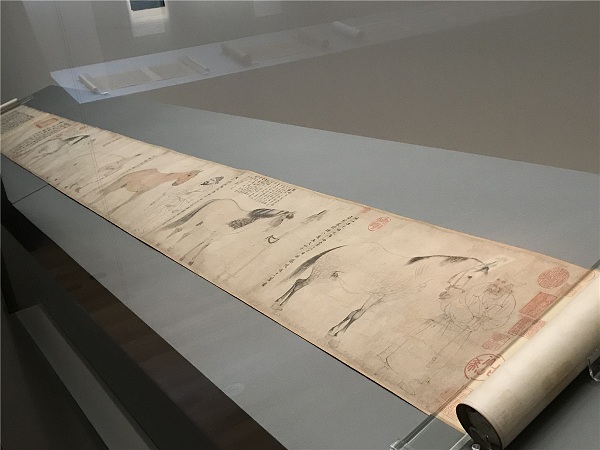
Wang Shizhen (1526-1590), an important historian and writer in the Ming Dynasty, wrote books of equal size and loved art and literature, covering almost all cultural fields at that time. He has dominated the literary world for 20 years, with rich literary talent and historical comments, he observed and recorded the prosperity of the Ming Dynasty in the 16th century.
The Paper learned that on October 5th, "Writing Prosperity - Wang Shizhen, a Cultural Man of the Late Ming Dynasty and His Career" was exhibited at the National Palace Museum in Taipei. Through his life and his career, he has a glimpse of the cultural splendor of the late Ming Dynasty, and understands the cultural life full of creativity and diverse competition at that time.
It is reported that there are 8 calligraphy and paintings in the exhibition limited to the National Palace Museum in Taipei, including Jin Wang Xizhi's "Fast Snow and Clear Post", Tang Huaisu's "Self-narrative Post", Dong Yuan's "Longsu Suburbs" in the Southern Tang Dynasty, Yuan Zhao Mengfu's "Magpie Flower" Autumn Colors, etc., are all illustrious monuments in the history of art. It is worth noting that the rare earliest engraved version of Jin Ping Mei, "Jin Ping Mei Cihua", also appeared in the exhibition in the 45th year of Ming Wanli. The organizer said that this word is likely to be Wang Shizhen's work of revenge. The author relies on his powerful cultural discourse power. Together with history scholars, through writing and historical writing, the image of Yan Song's father and son's traitorous officials was firmly rooted in the people, and it was also permanently recorded in the annals of history.
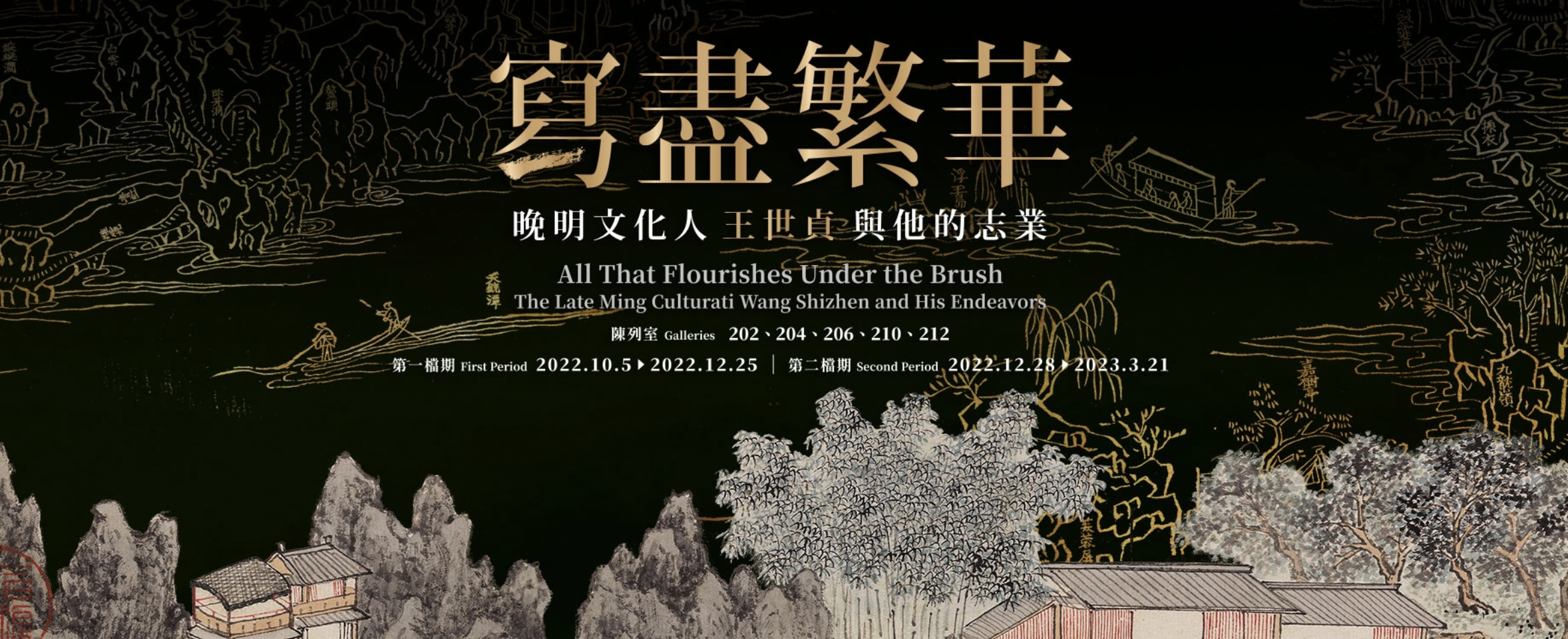
"Writing Prosperity - Wang Shizhen, a Cultural Man of the Late Ming Dynasty and His Ambition" poster
Wang Shizhen (1526-1590), courtesy name Yuanmei, nicknamed Fengzhou, also known as Shanren of Yanzhou, was a native of Taicang Prefecture, Suzhou Prefecture (now Taicang City, Jiangsu Province) in southern Zhili, and was a writer and historian in the Ming Dynasty. Wang Shizhen, a young and successful young man, was admitted to the jinshi at the age of 22, but suffered a great change at the age of 34. After his father Wang Yan (1507-1560) was tragically framed, he faded out of the political circle, and then stayed in his hometown most of the time, engaging in writings, traveling, making friends, appreciating and other activities. He has a lot of collections, and he is deeply involved in gardening, painting and calligraphy, ancient books, ceramics, embroidery and curios.
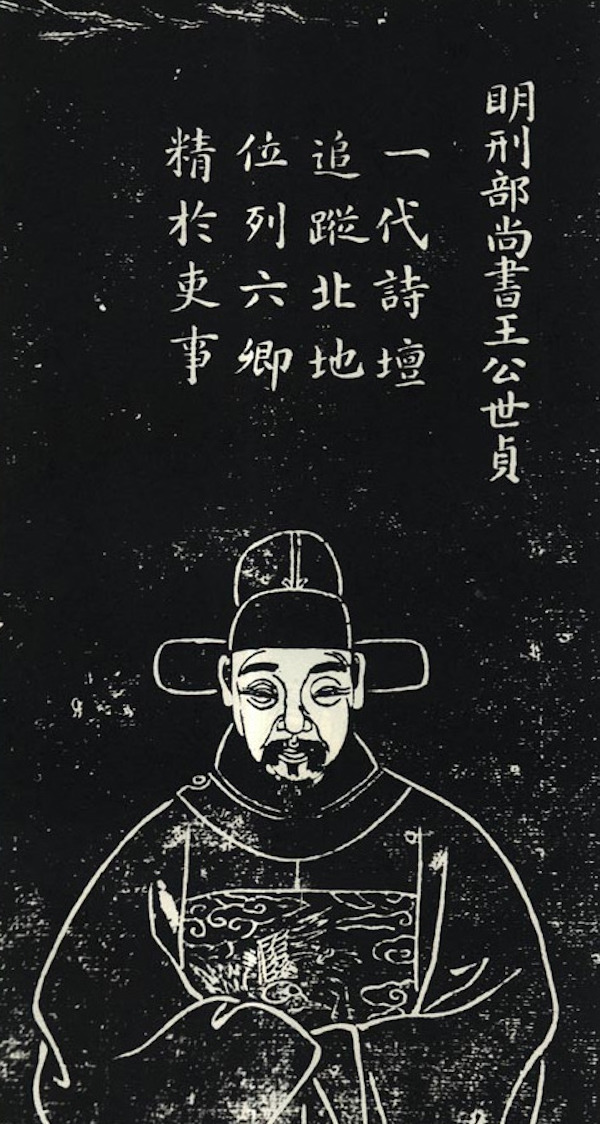
Portrait of Wang Shizhen (1526-1590) (not in this exhibition)
Wang Shizhen, who has dominated the literary world for 20 years, particularly admires the calligraphy of the Jin and Tang Dynasties, the paintings of the Song Dynasty, and the porcelain of the Song Dynasty, and advocates the use of pictures to prove the history. He put forward the concept of "Five Changes in the History of Painting", clearly pointing out the changes in style of the times. Wang Shizhen also commented on contemporary art and craft creation. He specially recommended the "three schools of Wuzhong" in calligraphy, distinguished and analyzed the phenomenon of kesi forgery, and criticized the prevailing situation of Ming official kilns at that time, all showing that he has a keen eye and a non-traditional opinion.
In the regional competition at that time, he led Suzhou to engage in exciting and diverse cultural wrestling with emerging forces such as Huizhou and Songjiang. The rich literary talent and the in-depth commentary made Wang Shizhen highly respected by the public and become an authority on cultural taste certification. Through the creation of gardens, advocating religious beliefs, discovering neglected documentary landscapes, and advocating new fashions such as Jiyou Tutu, etc., it has brought a new trend of popularity.
He believed that "there is nothing more than history between heaven and earth", so he focused on collecting and arranging historical materials, and his critical and rich writings became the basic materials for later generations to write "History of the Ming Dynasty". and take revenge on his father. Through comprehensive observation and in-depth commentary on various artistic and literary developments, he recorded the cultural pomp of the Ming Dynasty for the later century.
In recent years, research on Wang Shizhen has been very popular in the academic world. The rich collection of the National Palace Museum in Taipei can just show Wang Shizhen's lifelong career, how he used his talent and cultural capital advantages, and left many remarks that influenced later generations with the macro vision of historians. Actively leading various arts and cultural activities, thus shaping the cultural landscape of an era.
Wedges: Collecting and Home Difficulty
It is widely rumored that Yan Song (1480-1567) failed to seize the "Along the River During the Qingming Festival", and took the opportunity to retaliate. Shizhen's father Wang Yan was captured and died. For revenge, it is said that Wang Shizhen wrote the well-known "Golden Plum". The grievances and grievances of the Yan Wang family are complicated and bizarre, and it is difficult to tell whether the story is true or false. However, after Yan Song's fall from power, the list of home raids "Tian Shui Bing Shan Lu" and "Qian Shan Tang Calligraphy and Painting Notes" did show his amazing and extravagant wealth. Whether it is the collection of Yan Song's father and son, or the world in the book "Jin Ping Mei", it is full of prosperity and attention to material life in the late Ming Dynasty. Wang Shizhen, who came from a family of officials, was also familiar with calligraphy and painting appreciation since he was a child, and lived a life of extraordinary taste. The confrontation of political forces and the competition of luxury tastes turned into gatherings and dispersal of collections, which opened the prelude to the prosperity of the late Ming Dynasty.
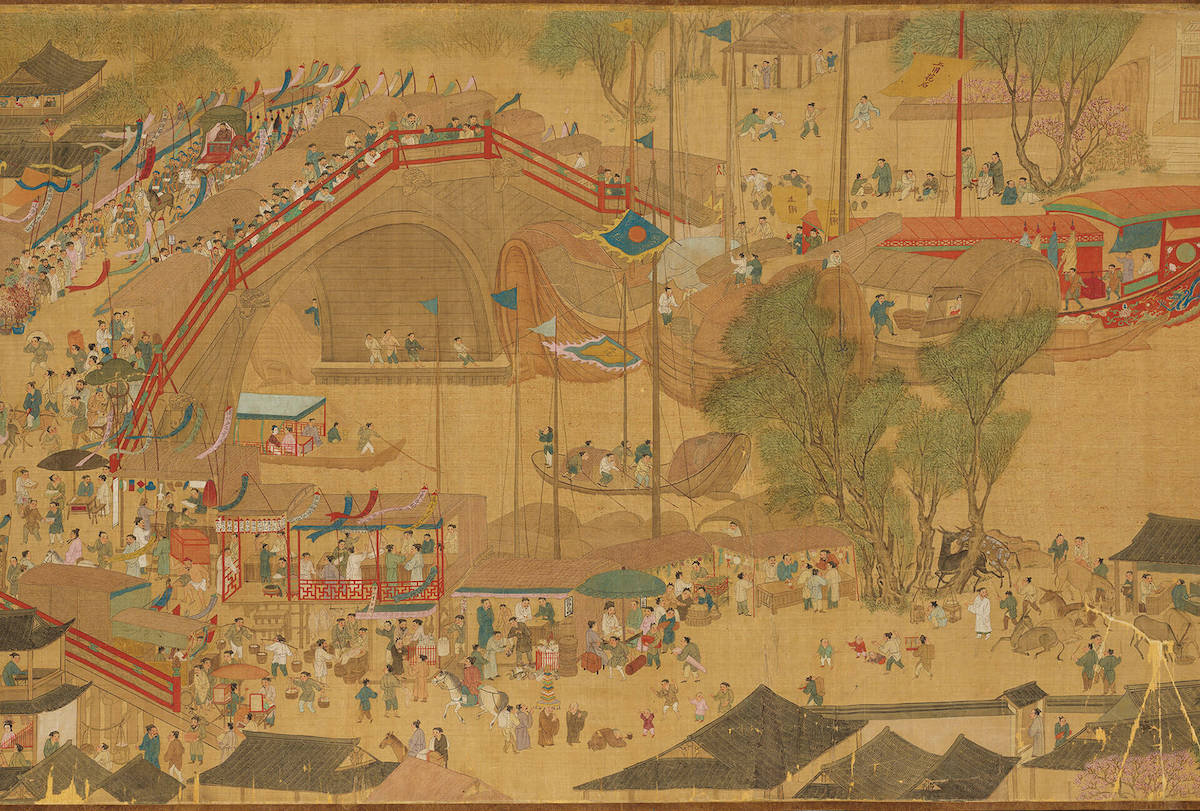
Song Zhang Zeduan Qingming Easy Sketches Volume (detail) first file 10.5-12.25
Zhang Zeduan's "Qingming Yijian Tu" scroll has fake seals of Wang Shizhen and Yan Shifan (1513-1565), which are presumed to be forgers in the late Ming Dynasty. (1480-1567) The story of father and son, who later caused trouble and death, deliberately made a book to raise the price and credibility of the painting.
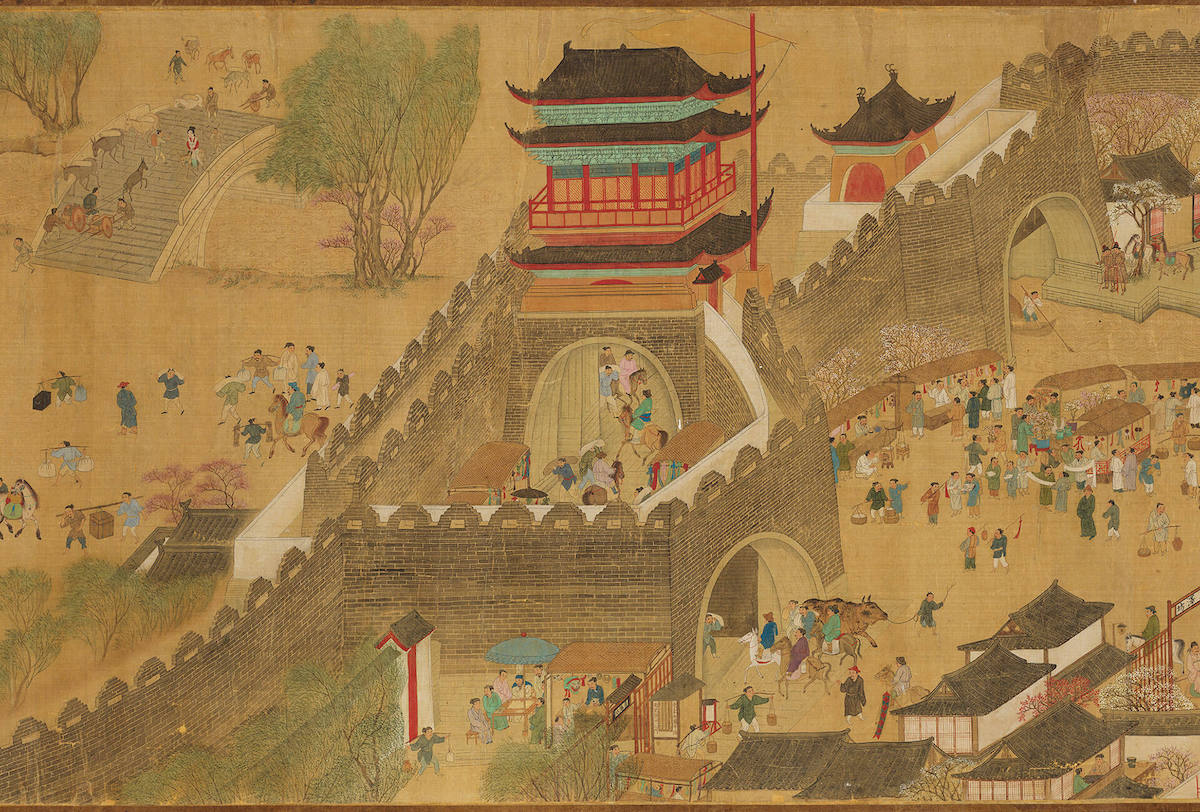
Song Zhang Zeduan Qingming Easy Sketches Volume (detail) first file 10.5-12.25
At the end of the volume, there is the inscription "Hanlin Painting History Minister Zhang Zeduan Advances", and many signs, such as "Sun Haoshou Steamed Bun", "Pan Jia Huang Qi Yuan", etc., are the same as those recorded in "Tokyo Meng Hua Lu". The faces and postures of the characters are very carefully depicted, and the activities are lively and rich, which is a masterpiece in the copy.
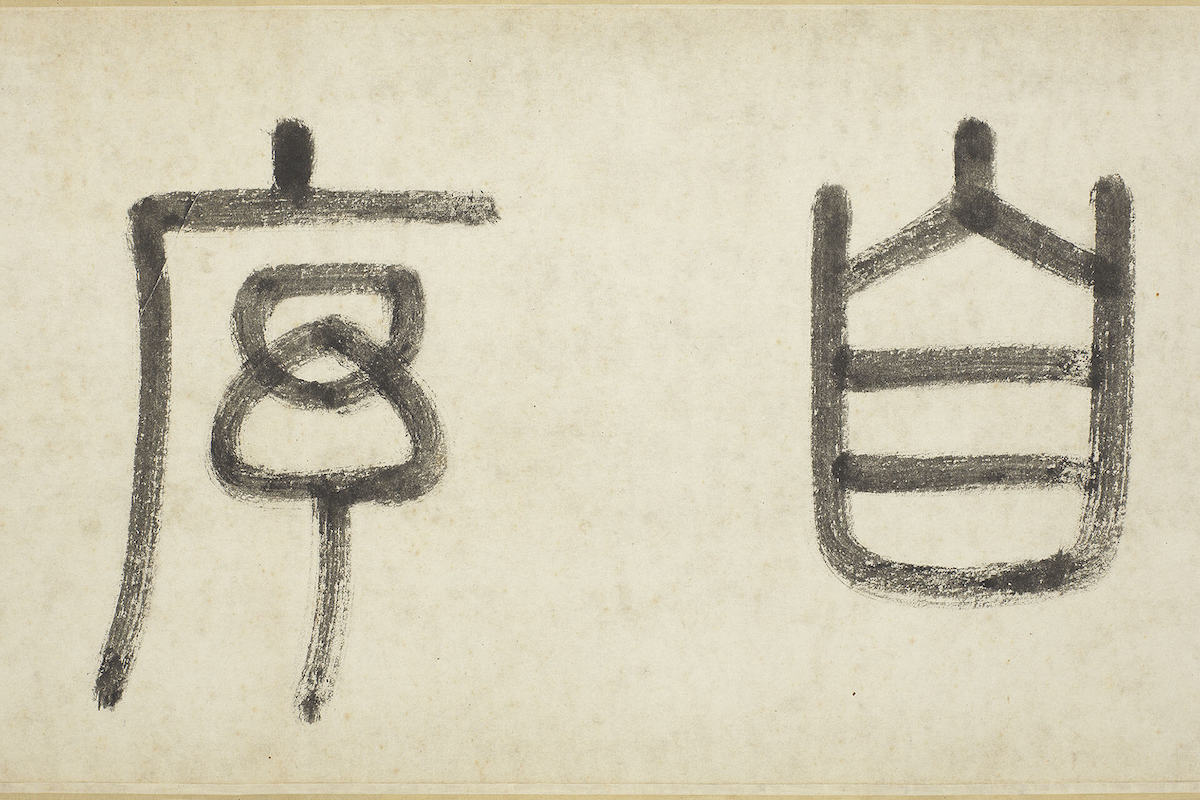
Tang Huaisu's Self-narratives, Volume (Part), National Treasure No. 1, 10.5—11.15 (Exhibition only)
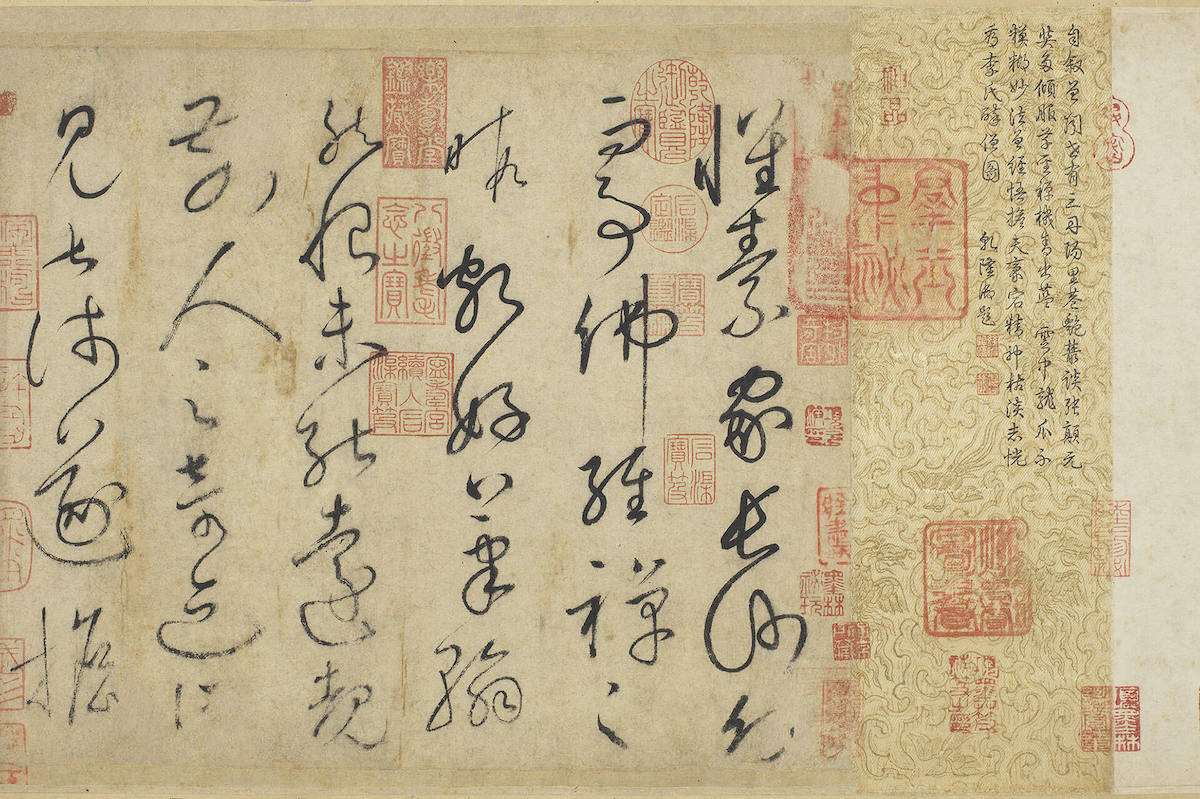
Tang Huaisu's Self-narratives, Volume (Part), National Treasure No. 1, 10.5—11.15 (Exhibition only)
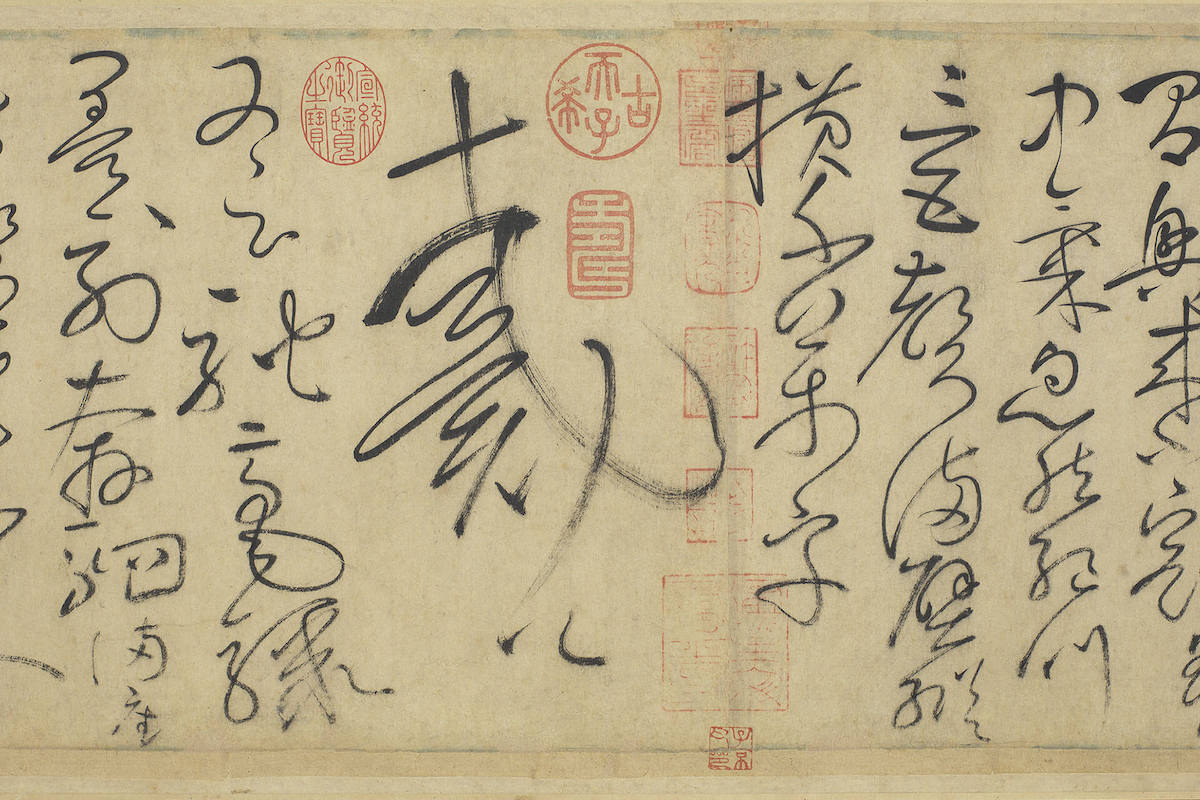
Tang Huaisu's Self-narratives, Volume (Part), National Treasure No. 1, 10.5—11.15 (Exhibition only)
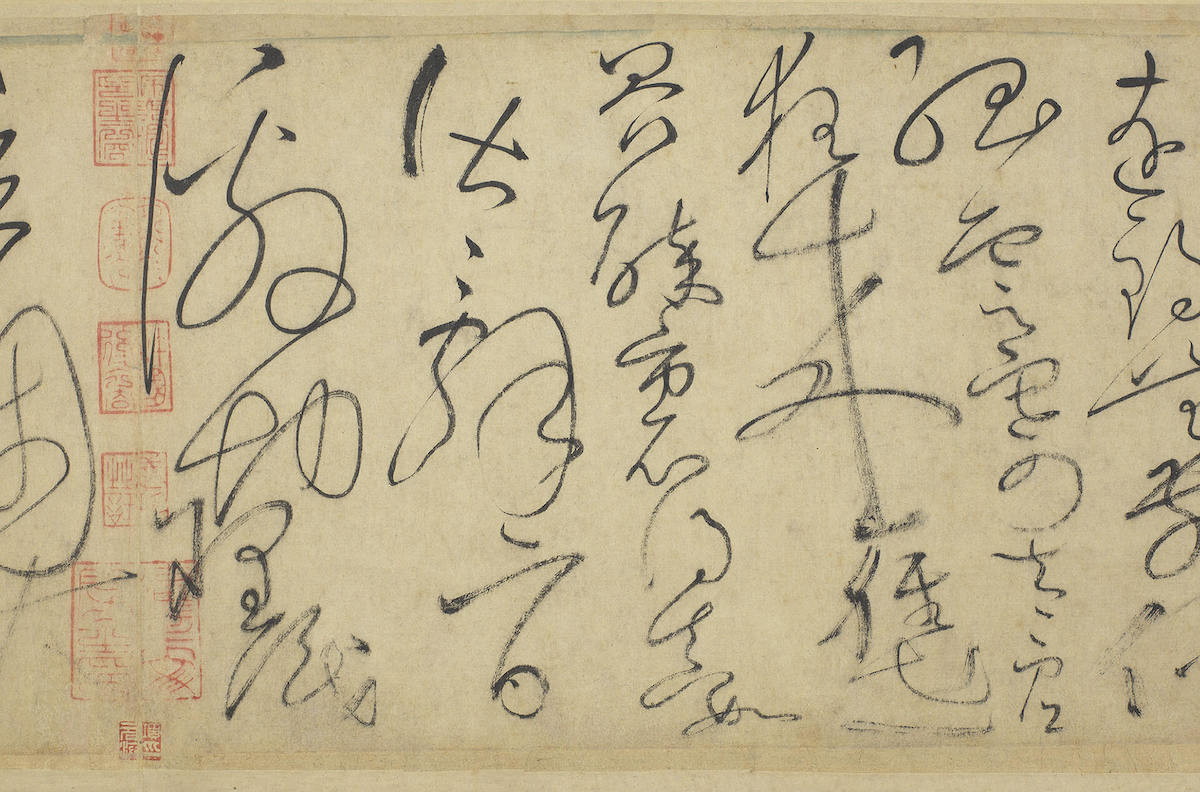
Tang Huaisu's Self-narratives, Volume (Part), National Treasure No. 1, 10.5—11.15 (Exhibition only)
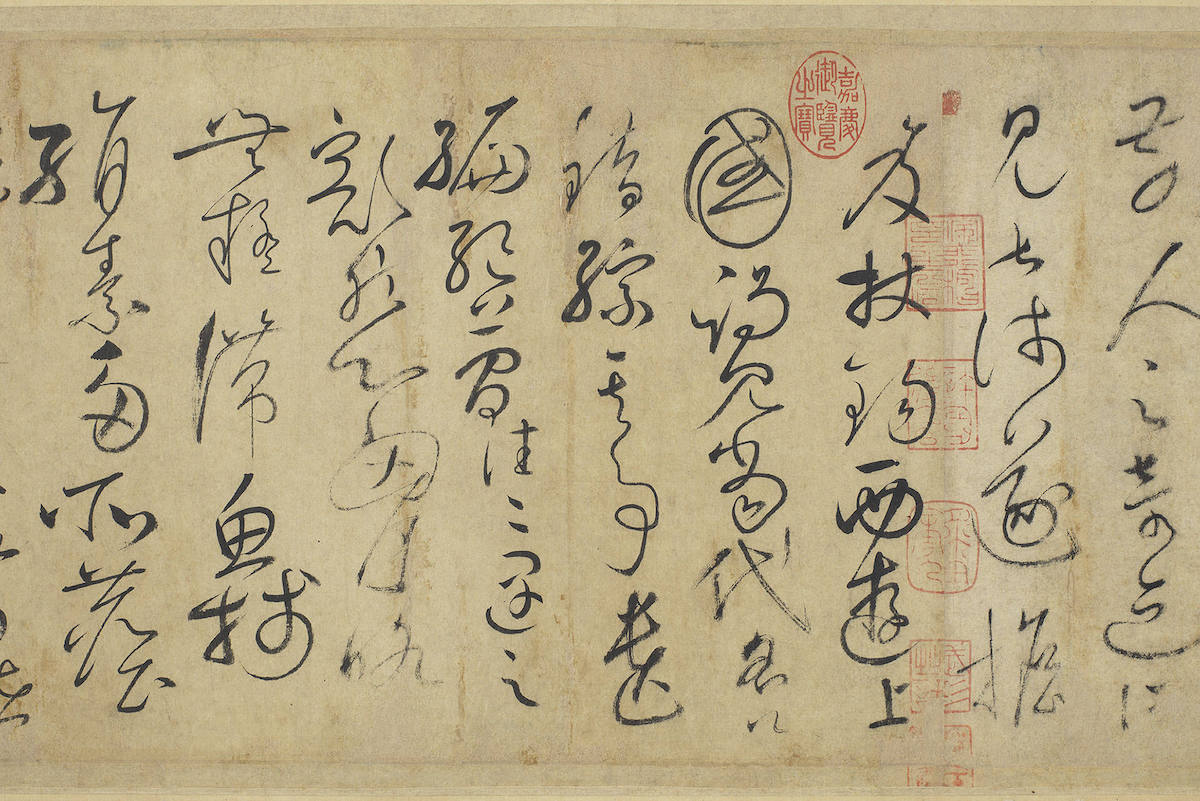
Tang Huaisu's Self-narratives, Volume (Part), National Treasure No. 1, 10.5—11.15 (Exhibition only)
Huai Su (about active in the second half of the eighth century), whose real surname is Qian, and whose character is Zangzhen. Born in Hunan, and later went to Chang'an, the cursive script was appreciated by Yan Zhenqing (709-785) and other celebrities, and excerpts were written in this volume in the 12th year of the Dali calendar (777). The cursive characters are written in fine strokes, and the whole works are strange and changeable, and the spirit is turbulent without losing the law.
Trailing Wen Zhengming (1470-1559) postscript, this volume is the collection of Su Shunqin (1008-1048) in the Northern Song Dynasty. It was circulated in Suzhou in the middle and late Ming Dynasty, and it was once held by Yan Song (1480-1567) who framed Wang Shizhen's father.

Song Huizong's Poems Volume (Part) National Treasure No. 2 2023.2.8—3.21 (Exhibition only)

Song Huizong's Poems Volume (Part) National Treasure No. 2 2023.2.8—3.21 (Exhibition only)

Song Huizong's Poems Volume (Part) National Treasure No. 2 2023.2.8—3.21 (Exhibition only)
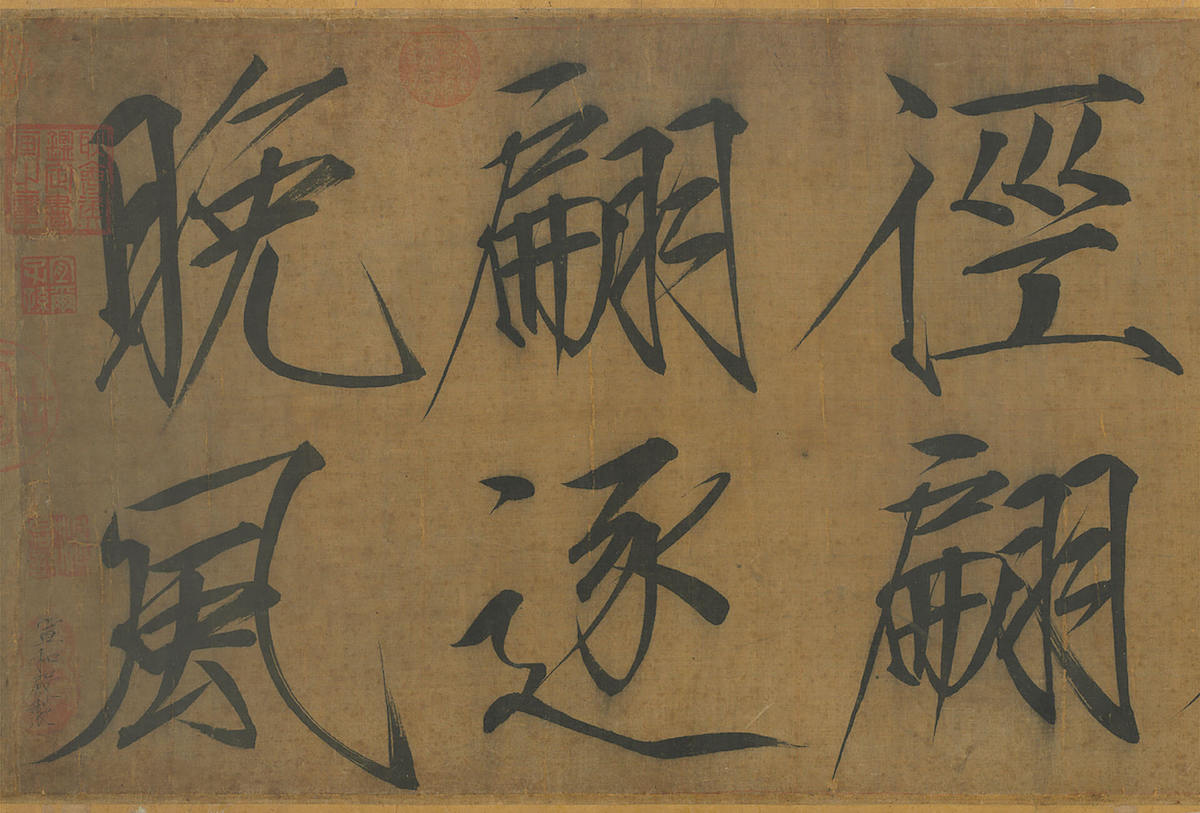
Song Huizong's Poems Volume (Part) National Treasure No. 2 2023.2.8—3.21 (Exhibition only)
Song Huizong (1082-1135), surnamed Zhao Mingji, the eleventh son of Shenzong (1048-1085), and the younger brother of Zhezong (1077-1100). Like art, calligraphy and painting are all exquisite. The cursive writing style is strong and elegant. Huang Tingjian (1045-1105), Yuanzong, Xue Ji (649-713), he is handsome and thin.
This volume can be found in the "Qianshantang Painting and Calligraphy", which was copied from the private property of Yan Song (1480-1567), and the front of the volume still has the "Nanchang County Seal" half-printed in the Ming Dynasty, which is sufficient proof that it was once collected by Yan's family. It is the work with the largest font in the extant calligraphy of Song Huizong.
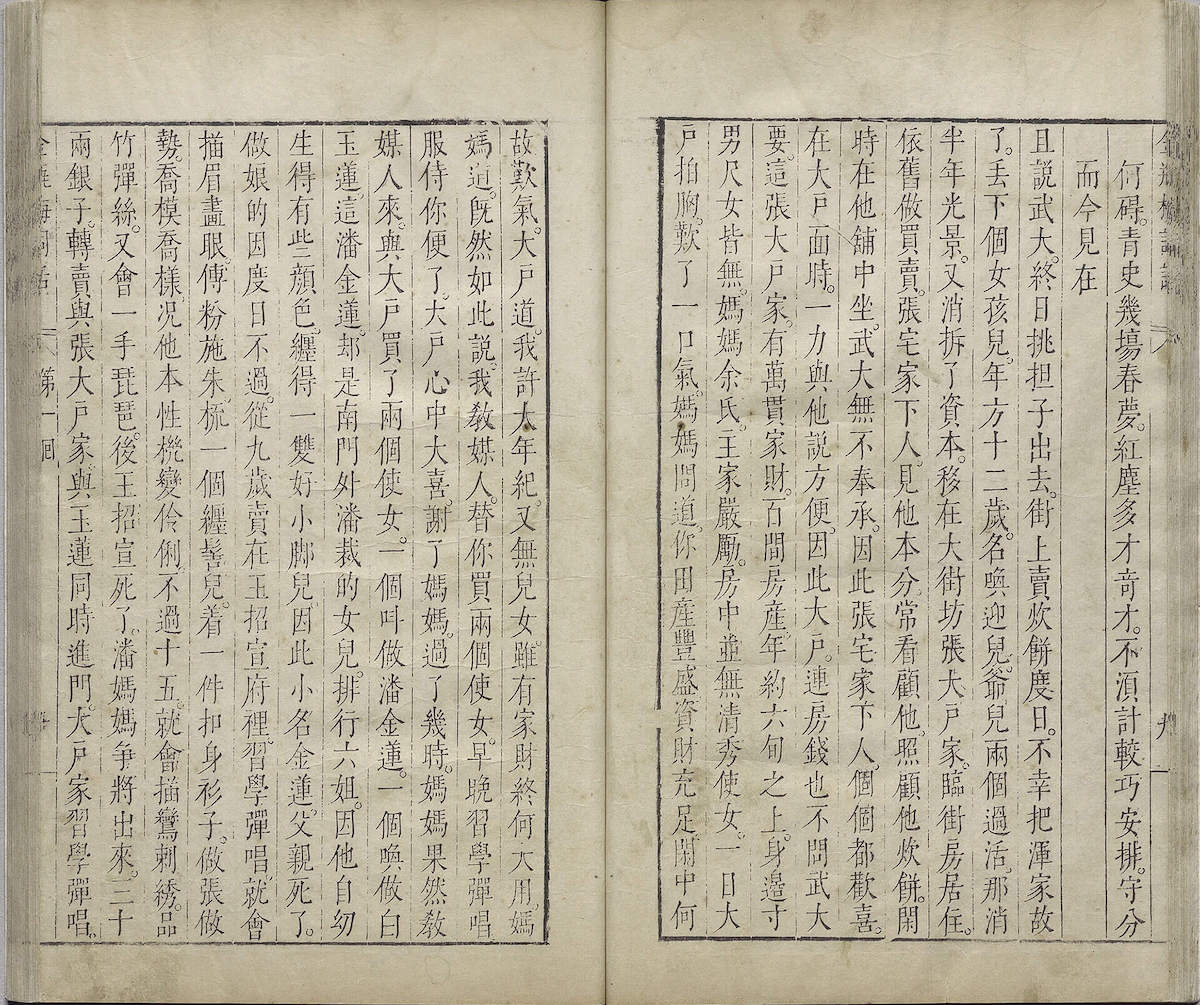
Ming Lanling Xiaoxiao Sheng Jin Ping Mei Poems, Ming Wanli forty-five years edition
The author indicated in "Jin Ping Mei" is Lanling Xiaoxiaosheng. For a long time, Xiaoxiaosheng's true identity has been an unsolved mystery. However, after this book of strange love was published in the late Ming Dynasty, many people believed that the story was written by Wang Shizhen. The basis of the speculation comes from Wang Shizhen's resentment towards Yan Song (1480-1567) and his family, and he believes that Wang Shizhen's purpose of mocking and criticizing the Yan family through the writing of novels. Among them, by describing the corrupt bureaucracy formed by Ximen Qing and Cai Taishi, it alludes to the political actions of Yan Song's family that violated the etiquette and law, and the name "Ximen" Qing and Yan Shifan's (1513-1565) "Donglou" Zhai No. such an association.
Whole person development and authority building
Naturally gifted and unforgettable, Wang Shizhen has read a lot of books since childhood, has rich cultural capital, and stands out from the crowd. After the family disaster, he concentrated on literary and artistic activities and built the "Lizai Garden" to escape from the world. Later, he found a secluded place, built the "Yanshan Garden", and opened it to friends and close friends to visit. The garden became an important stage for social life. His extraordinary physical strength allows him to traverse all kinds of elegant gatherings. Wang Shizhen confronted Yan Song and Zhang Juzheng (1525-1582) in his early years, and he had the image of a heroic and righteous man; he continued to meet and form associations, and made friends all over the world; and then used his erudition and critical ability to create a set of literary criticism mechanisms. These All made him gradually become the center of attention. Soon, Wang Shizhen's influence spread to the whole country. After the death of Li Panlong (1514-1570), he led the literary world for more than 20 years and became a leader in the cultural world in the second half of the 16th century.
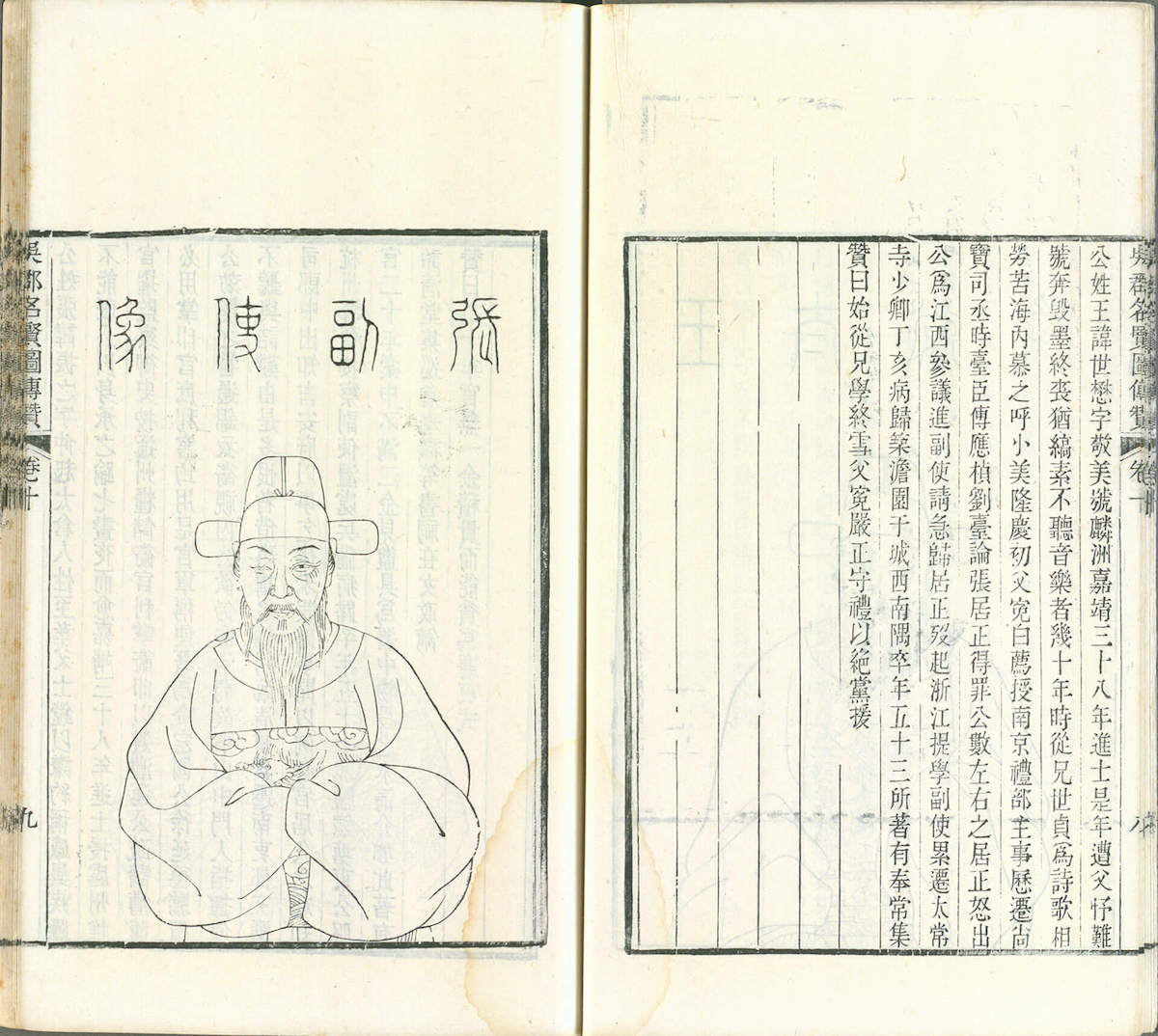
Qing Gu Yuan's compilation of pictures of famous sages in Wu County
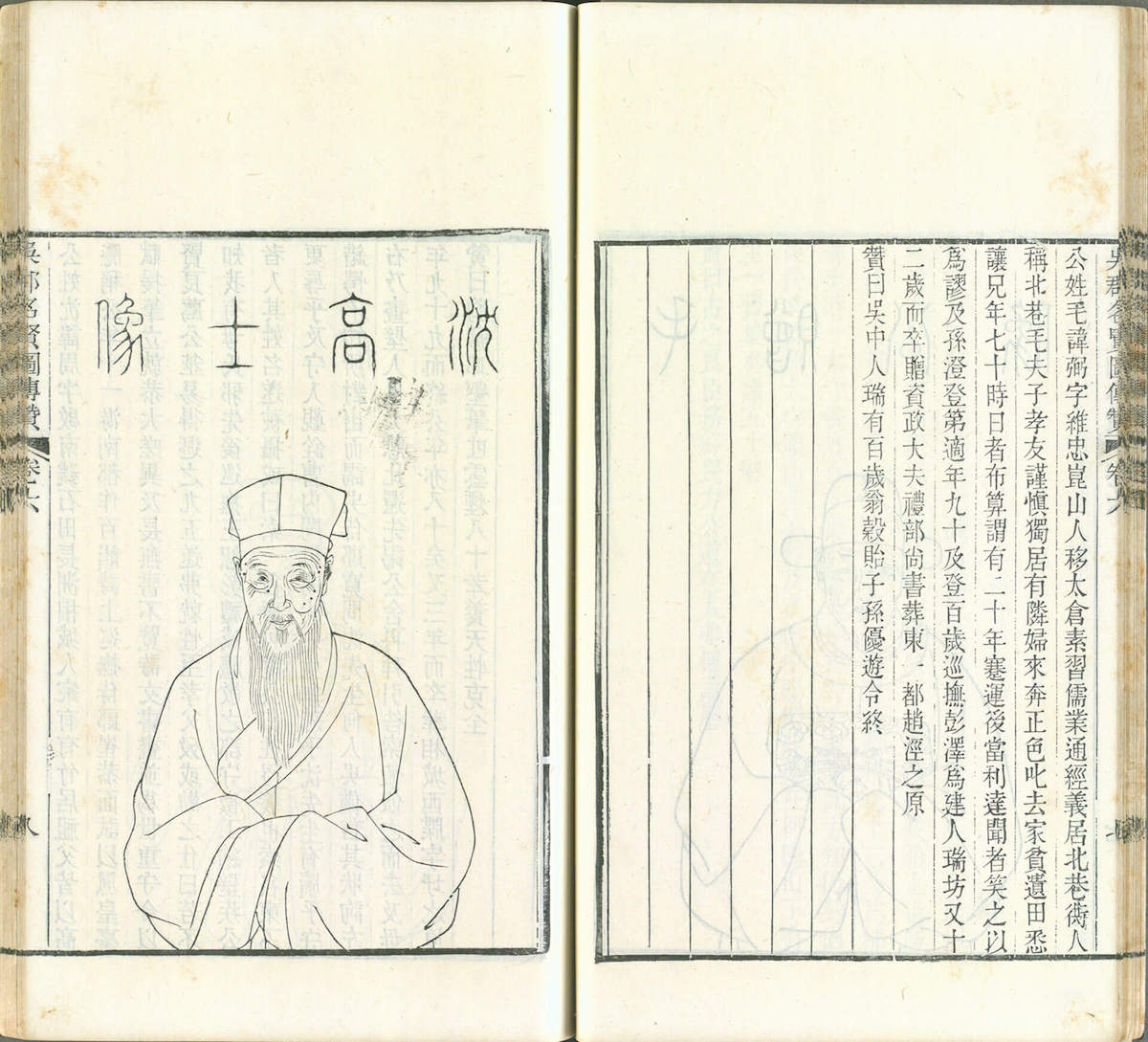
Qing Gu Yuan's compilation of pictures of famous sages in Wu County
Suzhou is rich in art and literature, and famous people are born in large numbers. The bibliophile Gu Yuan (1799-1851) collected 570 images of famous people from ancient and modern times. First, after the reconstruction of Canglang Pavilion during the Daoguang period, the craftsmen carved stones and embedded them into the walls of the newly built famous temple next to the pavilion; Tribute, engraved. The portraits of the brothers Wang Shizhen and Wang Shimao are all by Kong Jiyao. The clothes and accessories have been carefully verified, and no speculation is made. The faces of the characters are smiling and amiable. The compliments said that Shizhen was "skilled in official affairs", Shimao was "solemn and respectful", and the two brothers were "finally Xuefu's injustice", which can be described as a fair and accurate historical evaluation.
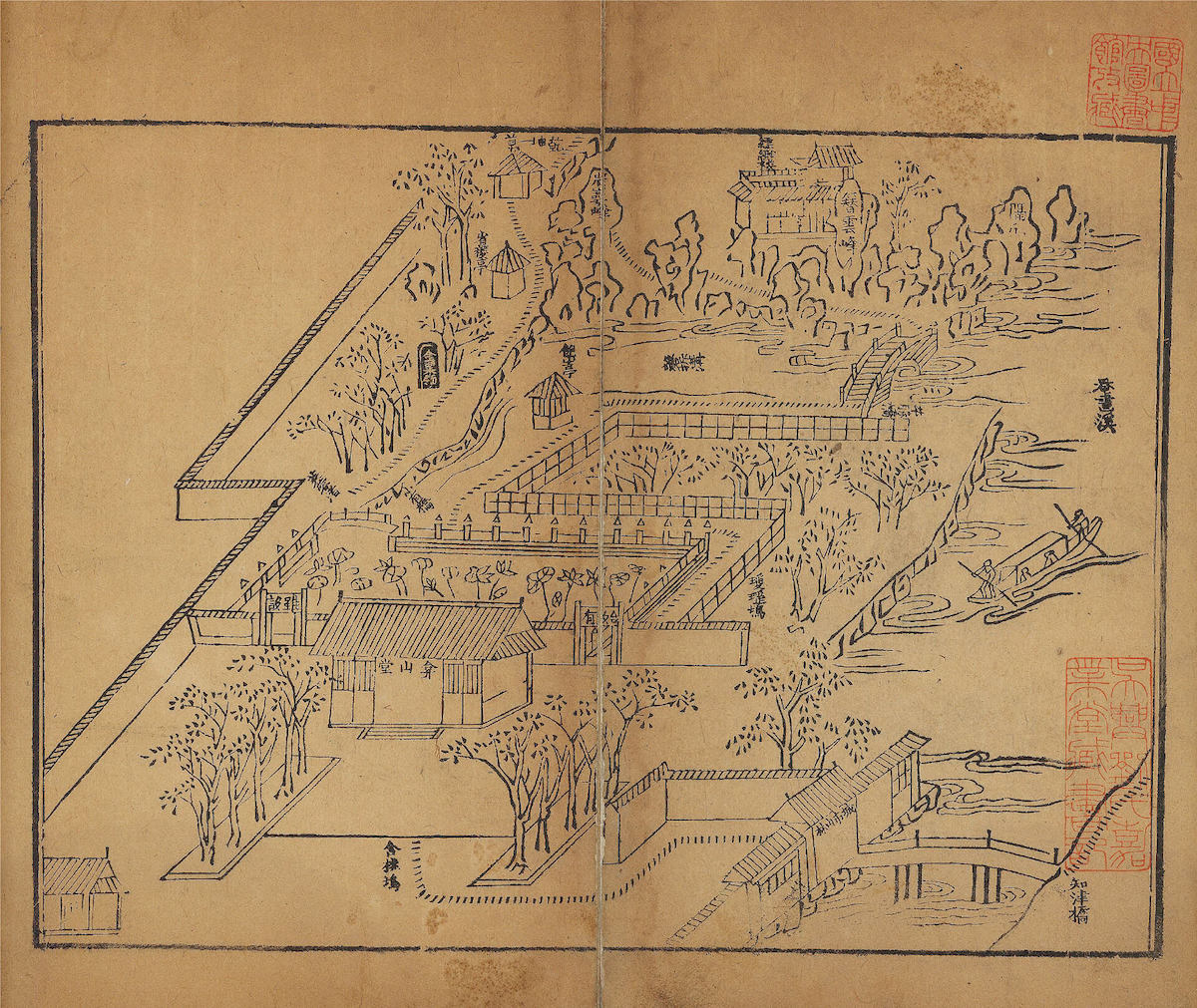
Ming Wang Shizhen Mountain Garden mixed with the Ming Wanli period
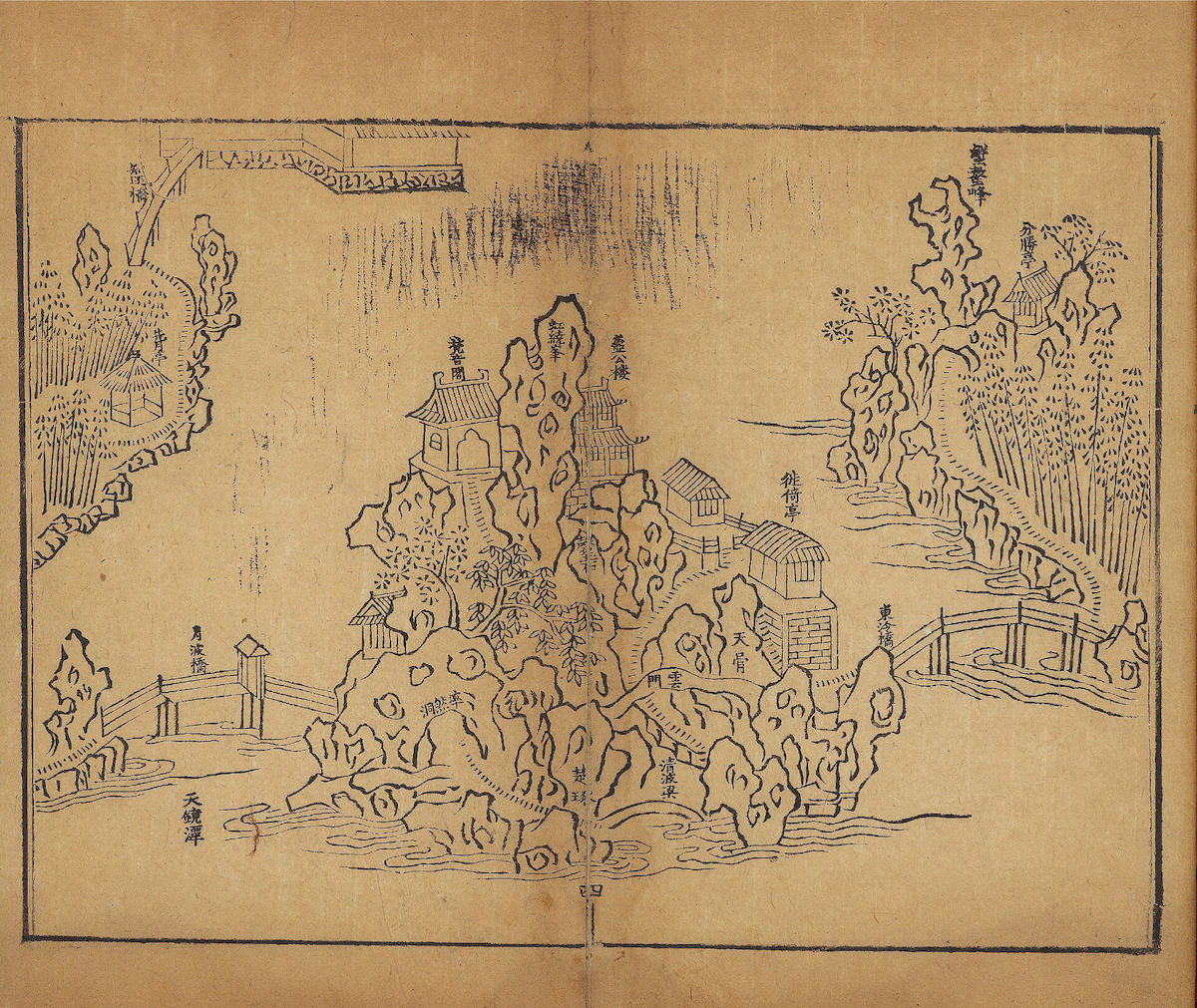
Ming Wang Shizhen Mountain Garden mixed with the Ming Wanli period
Wang Shizhen not only traverses the literary world, but also has a deep understanding of garden construction and evaluation, leading the trend of garden construction in the south of the Yangtze River. Wang Shi likes to visit famous gardens in various places, and there are many garden records handed down. He believes that physical gardens will eventually disappear, and only by resorting to words can they "keep people's eyes forever".
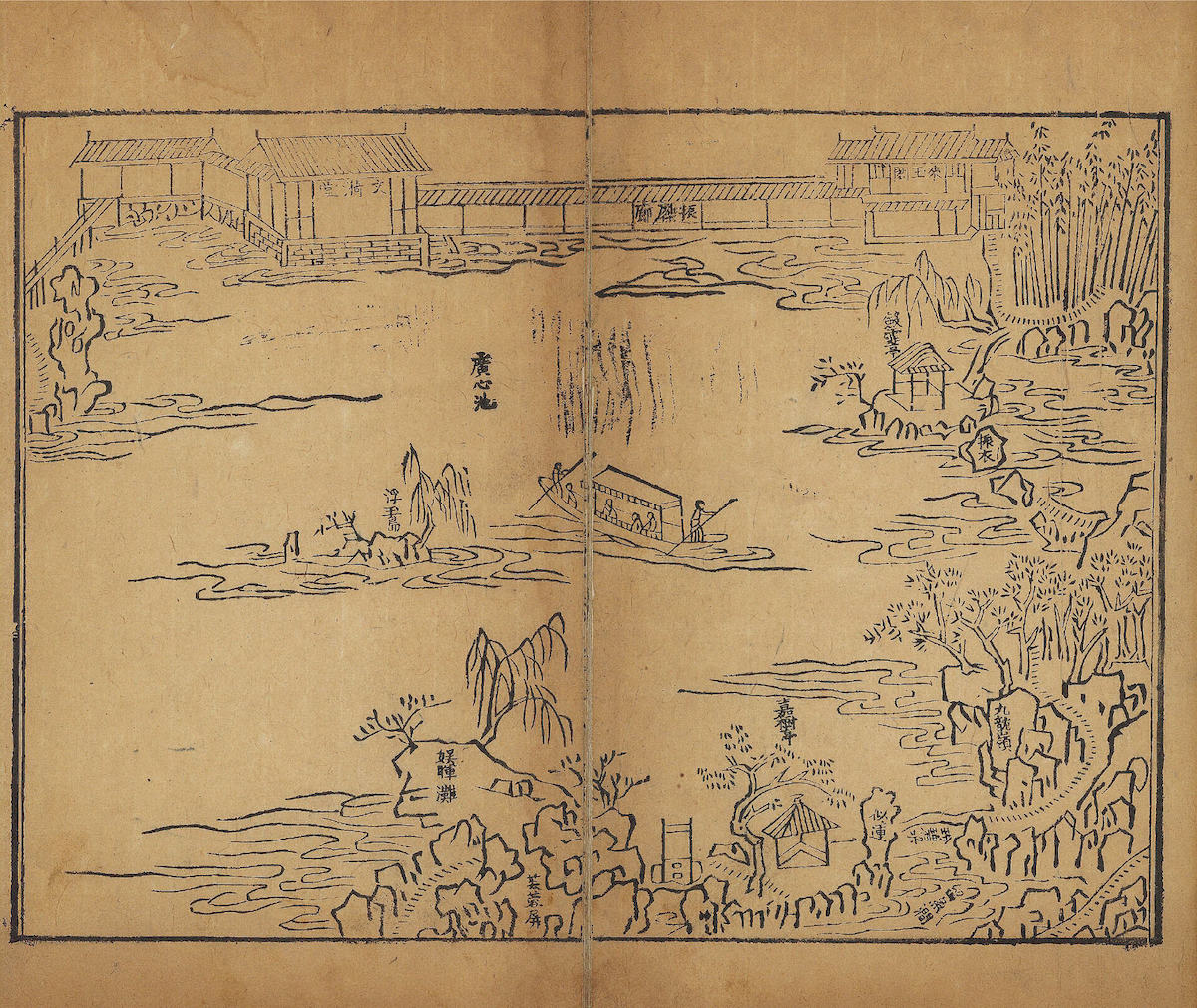
Ming Wang Shizhen Mountain Garden mixed with the Ming Wanli period
This book is divided into two volumes, including poems and essays on the garden of one's own garden. The front of the book presents part of the garden landscape with four prints. The self-preface mentions that the book "Replying for the rest" was edited. Wang Shizhen wrote eight garden diaries to introduce the garden scene, and presented the garden route through images, and responded to the common questions of the visitors. Garden guide book.

Ming Wang Shizhen Ming Han Xing Inkstone

Ming Wang Shizhen Ming Han Xing Inkstone
The inkstone is made in a rectangular hand-chasing style, and the bottom of the inkstone is hollowed out to form an inclined plane, and the hand can be stretched in and held up. There is a short column protruding beside the ink pool of the inkstone. The center of the column is a stone eye, which is green and slightly yellow, and is generally referred to as a "star". Stone eyes are nodules formed by the continuous accumulation of iron components during diagenesis. People in the Song Dynasty attached great importance to the stone eye, and imagined the stone eye in the black ink pool as a star or moon in the night sky, giving it an elegant artistic connotation. The inkstone wall is engraved with an inscription in cursive script by Wang Shizhen: "Jade is the quality, warm and shuddering; gold is the sound, and it is harmonious. Shizhen." This Ming imitation Song Yan fully reflects the admiration of Wang Shizhen and other Ming people for the culture of the Song Dynasty.
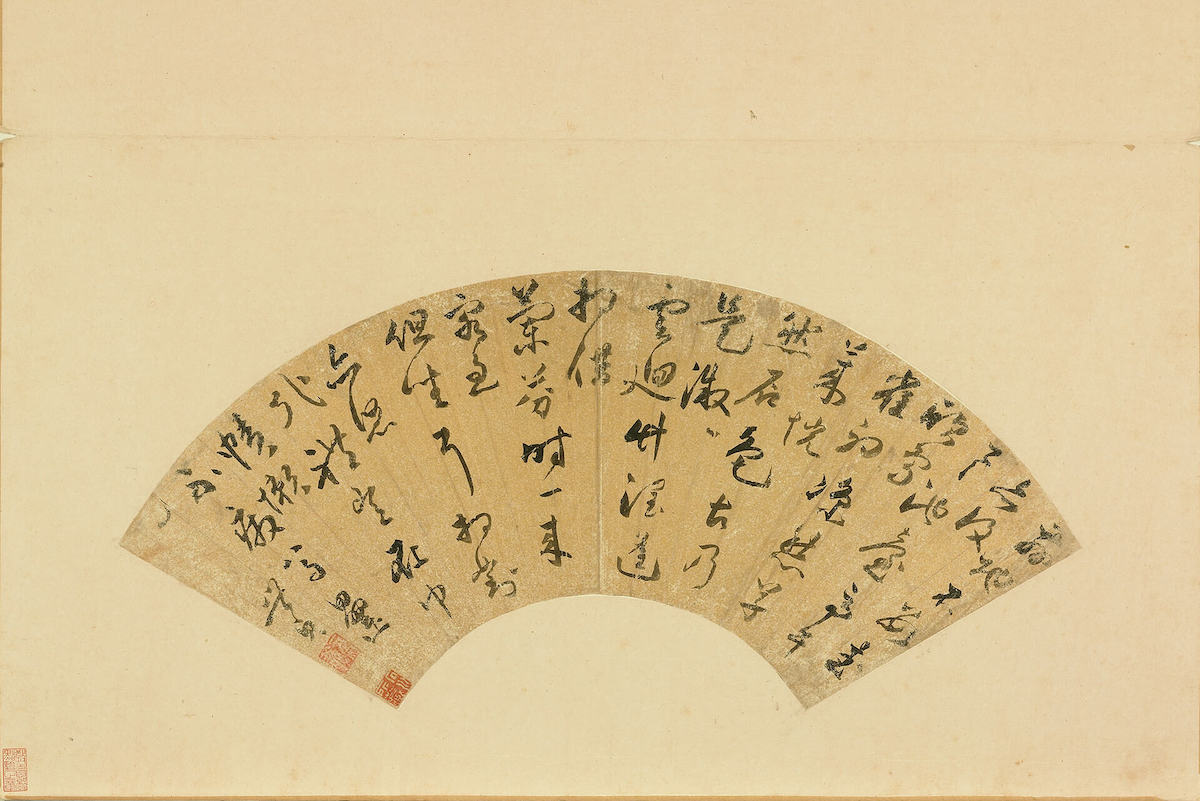
Ming Wang Shizhen's five-character cursive script second file 12.28—2023.3.21
Wang Shizhen's fan-faced books are rare, and this is one of them. The book "Leaving the Garden in Autumn is a Work of Things", and wrote a five-character ancient poem, which was included in the "Four Manuscripts of Shanren in Yanzhou". "Li Zhe Garden" is one of the private gardens built by Wang's family. It is located in Taicang (now Suzhou City) and was built in the 42nd year of Jiajing (1563).
Wang's calligraphy is known for its cursive style, and it reaches Tangao in the Wei and Jin Dynasties. Zhu Mouyao (1584-1628) called it "quaint brushwork". The pen is flexible throughout, and the ink color is rich in layers. The structure of the radical "⻍" of the word "yao" is related to Zhangcao, reflecting the origin and cultivation of calligraphy.

Tomorrow and Zhou Tianzhu Molan (partial) first gear 10.5-12.25
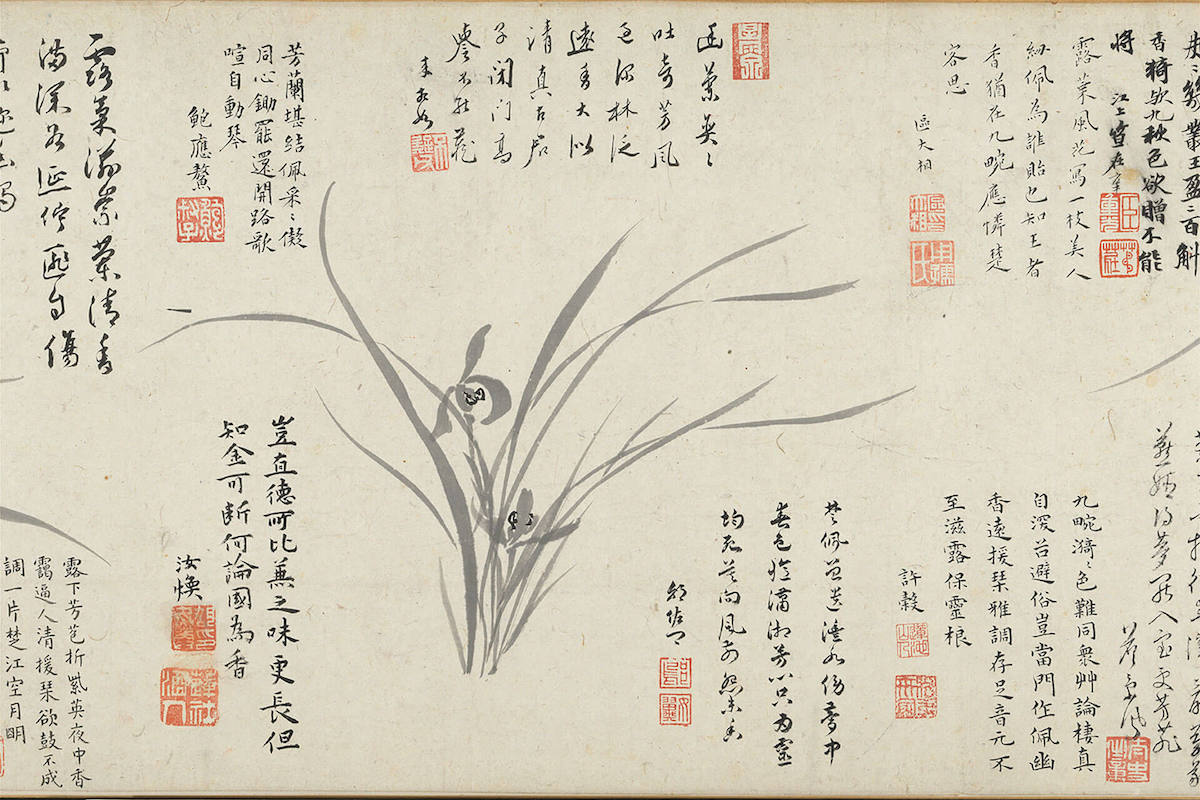
Tomorrow and Zhou Tianzhu Molan (partial) first gear 10.5-12.25

Tomorrow and Zhou Tianzhu Molan (partial) first gear 10.5-12.25
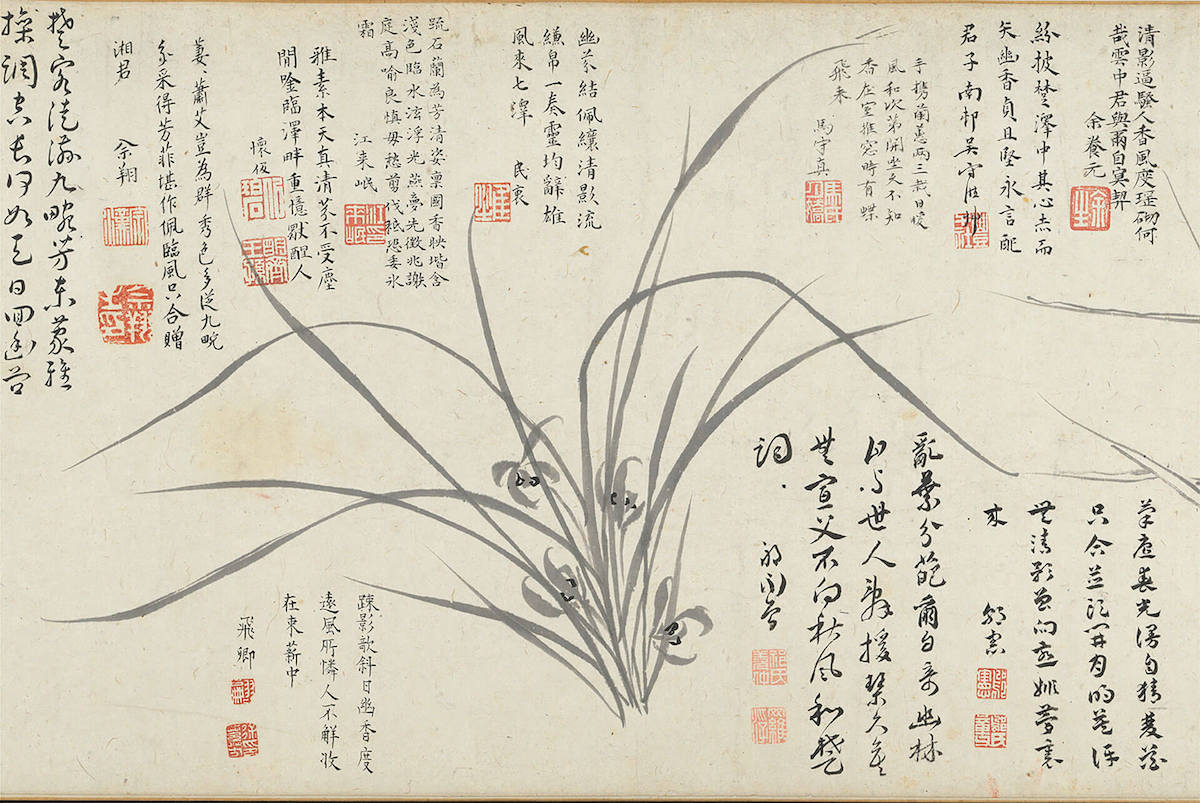
Tomorrow and Zhou Tianzhu Molan (partial) first gear 10.5-12.25
This scroll was made by Suzhou painter Zhou Tianqiu (1514-1595) in 1580 for Fang Yongbin (1542-1608), a Confucian merchant from Huizhou. The scroll is divided into ten sections with various orchid paintings, and there are more than 60 inscriptions in the blank space, including literati, famous prostitutes, and monks from Suzhou, Huizhou, Jiangxi, and Guangdong. From these inscriptions, we can see that the interpersonal network in Jiangnan at that time, many of which were friends of Wang Shizhen.
Wang Shizhen appreciates Zhou Tianqiu's calligraphy. This year, at the request of Wang Shizhen, he copied the Tao Te Ching again in exchange for Wang Shizhen's biography.

Ming Wang Shimao's seven-character rhythm poems in cursive script, the first file 10.5—12.25
Wang Shimao (1536-1588), courtesy name Jingmei, nicknamed Linzhou, was the younger brother of Wang Shizhen. In the thirty-eighth year of Jiajing (1559), he was a jinshi, and was appointed to Nanjing Taichang Shaoqing. He was good at calligraphy, and his brother urged him to quote him, saying: "My king's Mochi faction was wiped out for the dung of black clothes and horses, and now it's gone. Those who can be expected by the general public are my Ji'er."
This book "Jiao Shan visits Wang Boyu and Sima Shi Fang leads his children to set up a big house" is a seven-character rhythm poem, which is skillful in cursive and high-spirited. Wang Boyu was Wang Daokun (1525-1593), one of the last five sons. In the sixth year of Longqing (1572), he was promoted to the right servant of the Ministry of War, so he was called Sima. From this, it can be seen that the two are dating, and it can be speculated that they did it after the age of thirty-seven.
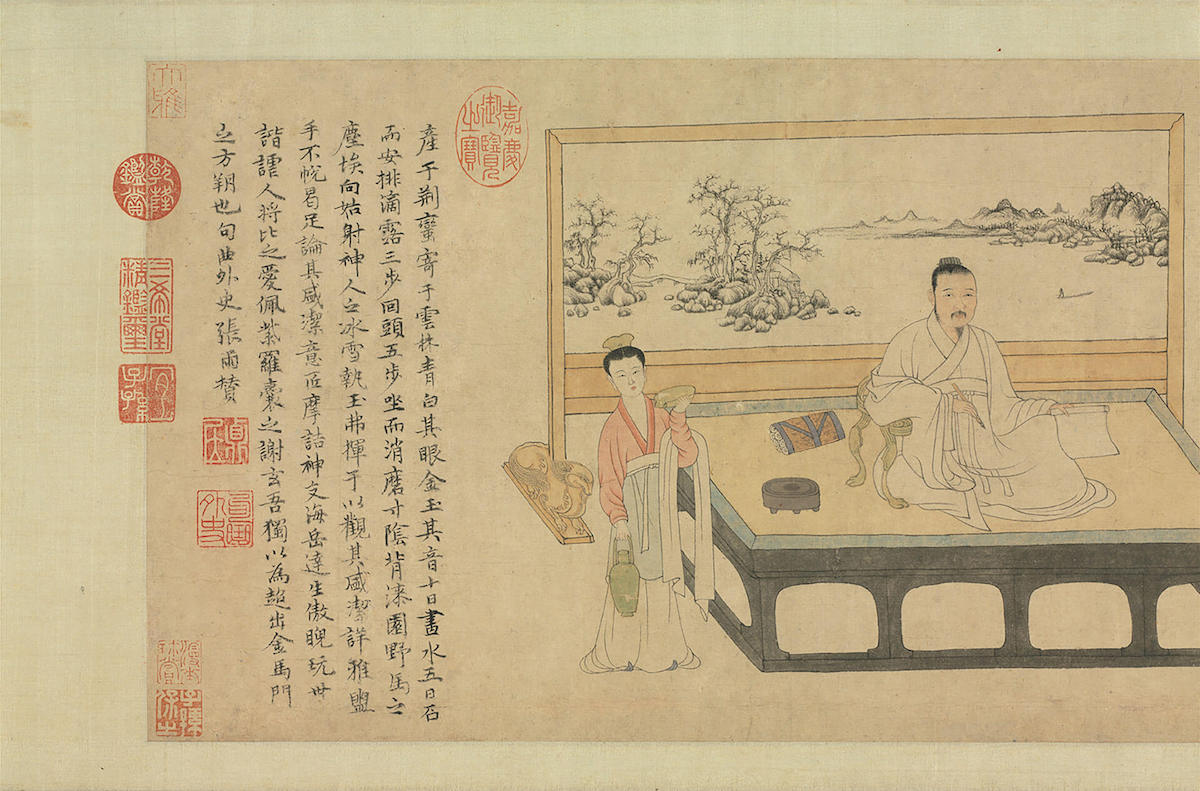
Yuan Zhang Yu's Inscription on Ni Zan's Statue, National Treasure Second Stage 12.28—2023.3.21
This masterpiece depicting Ni Zan (1301-1374), a scholar at the end of the Yuan Dynasty, has Wang Shizhen's postscript in 1565 at the end of the volume. From the adjacent contemporaneous inscriptions and postscripts, it can be seen that this famous monument was collected by Zhang Fengyi (1527-1613), a famous literati in Suzhou. After Wang Shizhen's father died in 1560, the Wang brothers returned to Suzhou for the mourning. It was not until the service was full in 1564 that he actively participated in the gatherings of Suzhou literati and made friends from all sides. An example of the postscript at the end of this volume can be seen in the elegant appreciation activities of mutual borrowing and viewing in Suzhou at that time.
Collections and classics give birth to a comprehensive view of art history
Wang Shizhen has been collecting calligraphy and painting for many years, and prefers to conduct in-depth research on the collection. Classified as one of the "late seven sons" of the Ming Dynasty, he advocated retrospective in literary creation, and seems to have a similar tendency in collection. Based on the cultural relics he saw, referring to the ancient books, and the ability to look at the overall situation, he gave birth to a different view of art, literature and history from those of his time. He praised the quaintness of the Wei and Jin Dynasties in calligraphy, which was different from the calligraphy of the Song Dynasty by the literati at that time. For the contemporary calligraphy circle, he put forward the argument of "three schools of Wuzhong", which is still the mainstream of calligraphy history. In painting, he believed that Song painting should be paid attention to, and opposed the mainstream view of Yuan Dynasty literati painting. He also put forward the proposition of "five changes in the history of painting", putting the evolution of painting style into the historical framework. its impact. He also has a good opinion about handicraft works. He believes that Song porcelain should be paid more attention to, rather than Xuande, Yongle and Chenghua official kilns in the art market. He also pointed out the status of the fake Song Dynasty Kesi at that time, which provided new materials and new horizons for related research. Through extensive and comprehensive records, Wang Shizhen reproduced the prosperity of the art market in the late Ming Dynasty and the grand development of the art world at that time. He also made in-depth comments from the historian's point of view of the past and the present, and had a far-reaching impact.

Four manuscripts by Shizhen of the Ming Dynasty
"The Four Manuscripts of Shanren in Yanzhou" is a collection of Wang Shizhen's early works, divided into 180 volumes in four parts: Fu, Poetry, Prose, and Said. Its "Speaking Department" includes seven works including "Yiyuan" and "Wanwei Yubian", showing Wang Shizhen's words on literary ideology and theory, as well as his profound knowledge of archaeological and historical records, forming an all-round artistic and cultural vision; It is also a pioneering work in the history of compilation of anthologies to juxtapose "shuo" with Fu, poetry and prose. The "General Catalogue of Siku Quanshu" commented on Wang Shizhen's "a wealth of talents and learning, and the scale is eventually large", and "examined the wealth of ancient collections. There is no one who surpasses Shizhen", accurately expressing his strong writing energy and influence.

Song Wuxian Songyin Courtyard Album 2nd file 12.28—2023.3.21
The work depicts a corner of the courtyard from a bird's-eye view. The main building has a hanging mountain roof, and the center is a hall. A woman will wake up in the daytime, and the maid in the eaves porch will either hold water or carry a bag. The Xumizuo-style flower platform in the garden is stacked with towering stones, with lush flowers and leaves on the side, and the painting method is very meticulous.
On the right side of the screen, there are half seals of "Zhen" and "Yuan", which are in the collection of Wang Shizhen. Wang Shizhen is a historian, who is engaged in the collection of calligraphy and painting and also pays attention to the development of painting history. He believes that the history of painting in different periods has its own characteristics, so the works of the Southern Song Dynasty also have unique significance of the times.
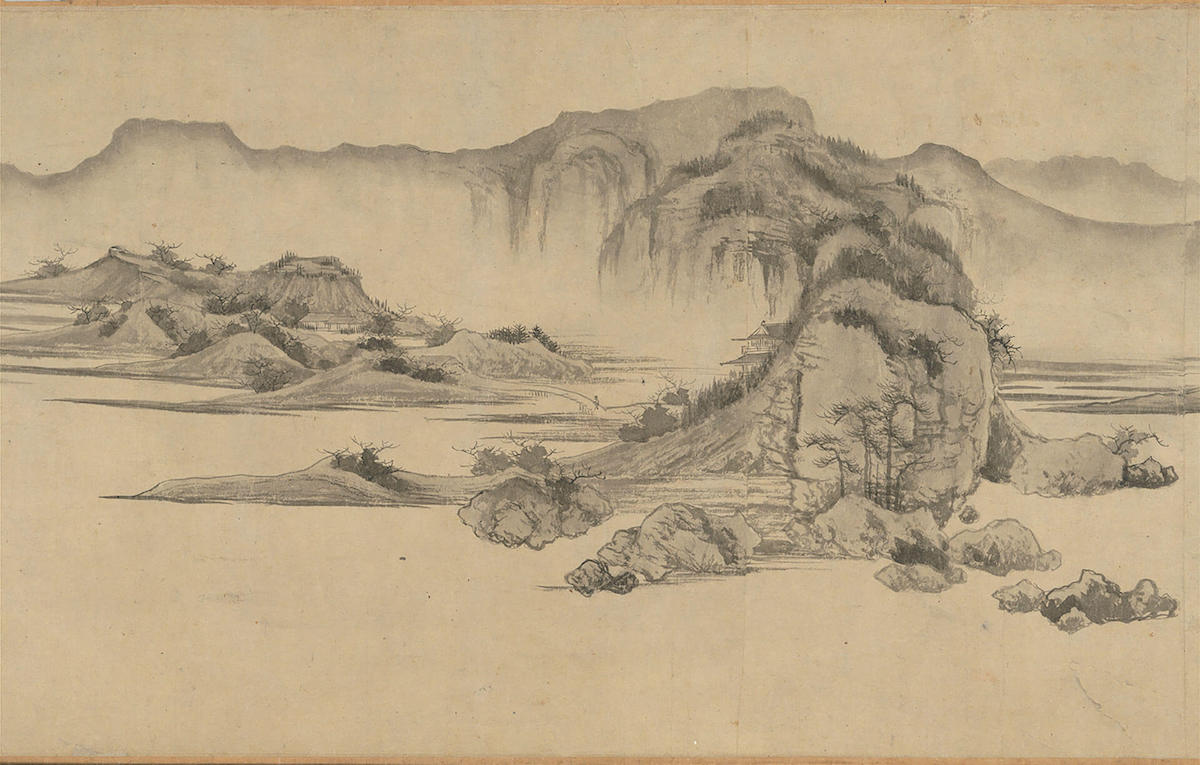
Yuan Zhao Mengfu Chongjiang Overlapping Mountains, Volume 1, National Treasure, 10.5—12.25
Wang Shizhen advocated the importance of Song painting, so when appreciating it, he often compared the painting with the works of the Five Dynasties and Northern Song Dynasty to show appreciation. "Chongjiang Overlapping Mountains" is an example. In the inscription and postscript, the painting is compared with Jing Hao (about 850-911) of the Five Dynasties, Li Cheng (916 967) and Guo Xi (after about 1023-1087) of the Northern Song Dynasty, which shows its admiration. This famous print is stamped with "Zhenyuan" at the head, and "Qiankun Qing Rewards" at the end, with a long text as a postscript, which is the standard style for Wang Shizhen to appreciate his own collection of paintings and calligraphy.

Tang Dynasty Emperor Ming Huang Xing Shu Figure Axis National Treasure 10.5—11.15 (Exhibition only)
It depicts the story of Tang Xuanzong (reigned 712-756) fleeing the An-Shi Rebellion and fleeing to Sichuan. The red-clothed brown horse was about to cross the bridge, and that was Tang Xuanzong. There are many copies of this painting in existence, and this one should be copied from Song Dynasty. There is a seal of Xiang Du's birthday on the painting, which shows that it was in the collection of the Xiang family, and that Qiu Ying (about 1494-1552), a friend of the Xiang family, has a copy that has been handed down. The full-scale green and heavy colors are rich in color, and the mountain and stone shapes are ancient and strange. It is the representative of the style of Li Sixun (about 653-718) and Li Zhaodao (675-758) in the Tang Dynasty, and it is also a typical Tang Dynasty landscape in the understanding of the Ming people. Wang Shizhen's view of the sunset over the sea and the sky is an example of this type of work.

Five Dynasties, Southern Tang Dynasty, Juran Layers, Rocks, Trees, Axis, National Treasure, 10.5—11.15 (Exhibition only)
Although this painting has an obvious Juran landscape style, it is still regarded as Juran's work, although it is not named. Juran (active in the second half of the 10th century), a native of Zhongling (now Nanjing). The Southern Tang Dynasty perished, and the Song Dynasty descended to Bianjing with Empress Li. Good at painting landscapes, he was a student of Dong Yuan (?-962), also known as Dong Ju in the history of painting. The long lines depicting the mountains, "Pai Ma and Cracks" and the conglomerate stones "Alum Head" on the top of the mountain, are the characteristics of Dong Ju's landscape. However, Dong Yuan mostly painted round and gentle hills in the south of the Yangtze River, while Ju Ran painted towering mountains with hemp and cracks. Wang Shizhen pointed out that "Jing, Guan, Dong, and Ju have changed again" is the second wave of changes in landscape painting, and Dong Ju is one of the Jiangnan style, which is in contrast with the northern style of Jingguan.

Song Fankuan Sitting Alone in the Stream, Axis National Treasure 2.8—3.21 (Exhibition only)
The majestic composition of the main mountain was attributed to Fan Kuan (about 950-1031) in the Qing Dynasty, although there was no painter's seal. This painting does have something close to Fan Kuan's style, such as the dense forest on the top of the mountain, the shape of the tree, the square fold with the outline of the mountain and the use of a side brush, which can be seen in the picture "Journey to Mountains and Streams". However, no raindrops were seen in the whole picture, the main mountain was a little weaker, and the fog filled it. The scribes sat alone by the water, which was different from Fan Kuan's style. This painting was once collected by Wang Xianchen of Suzhou (jinshi in 1493). Wang Shizhen also mentioned that there were new changes in landscape painting until Li Cheng (916-967) and Fan Kuan, which was a new development of landscape in the Northern Song Dynasty following the Tang and Five Dynasties.
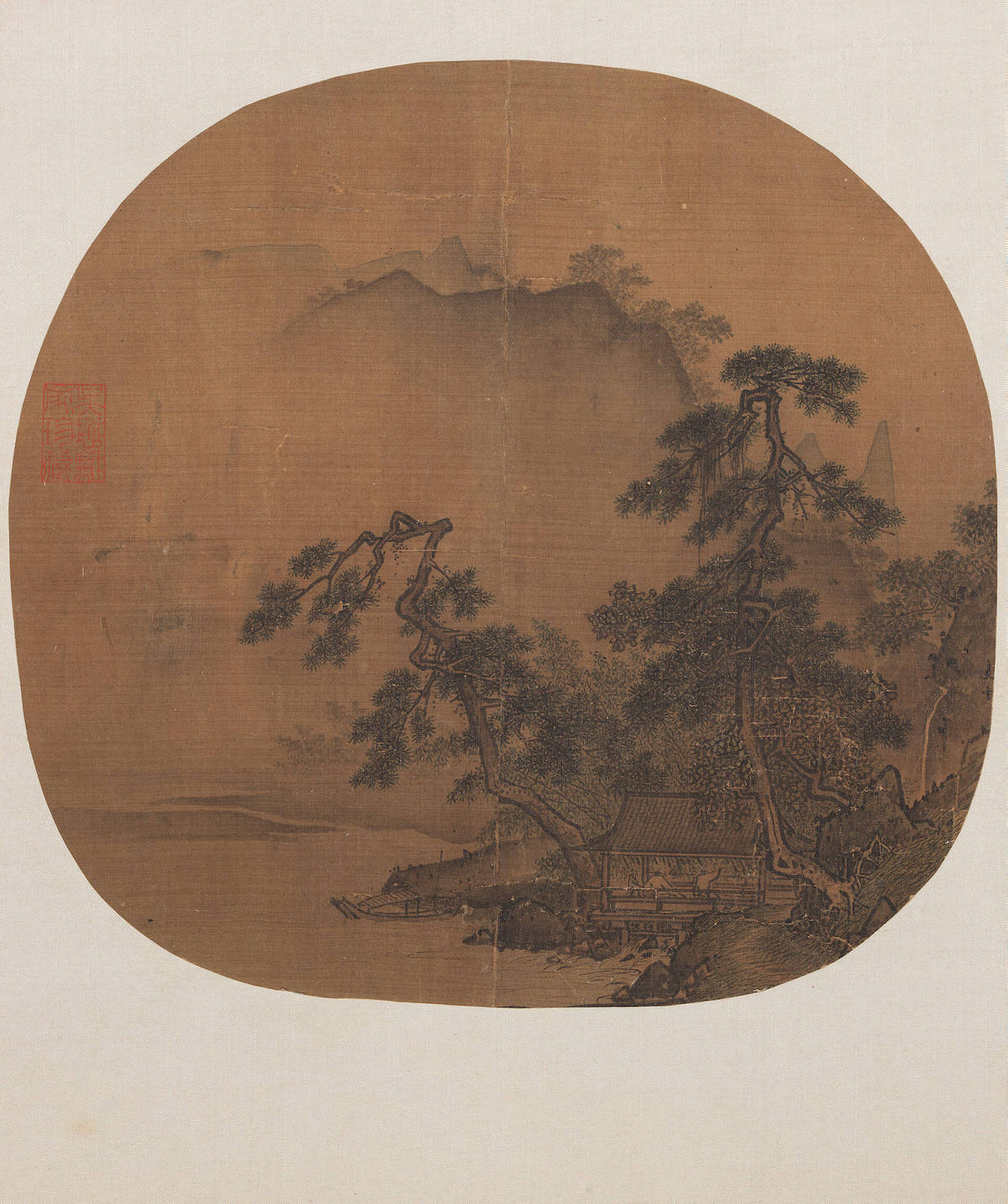
Song Xiagui's Waterfall Viewing Album Album National Treasure Second File 12.28—2023.3.21
On the right side of the fan, two giant pine trees stand up against the water pavilion. Among them is a child servant and two Yashi. One is sitting on the back, and the other is raising his finger to the right. There is a waterfall in the mountain, which slowly flows into a stream and crosses the water. Under the pavilion, it flows into the Prospect Lake. The close-up miscellaneous trees have red leaves, when it is early autumn. The distant mountains and rivers are misty and rainy, the boats on the shore are light, and the overall atmosphere is distant and comfortable. Southern Song painters often made edge-and-corner compositions, and were better at depicting natural scenery under specific seasons and weather changes. On the right side of the waterfall, there is an inscription "Xia Gui". As Wang Shizhen said, there were new changes in the landscape from the Southern Song Dynasty to Liu Songnian (1124-1182), Li Tang (about 1070-1150), Ma Yuan (active around 1190-1224), and Xia Gui (active around 1180-1230). .
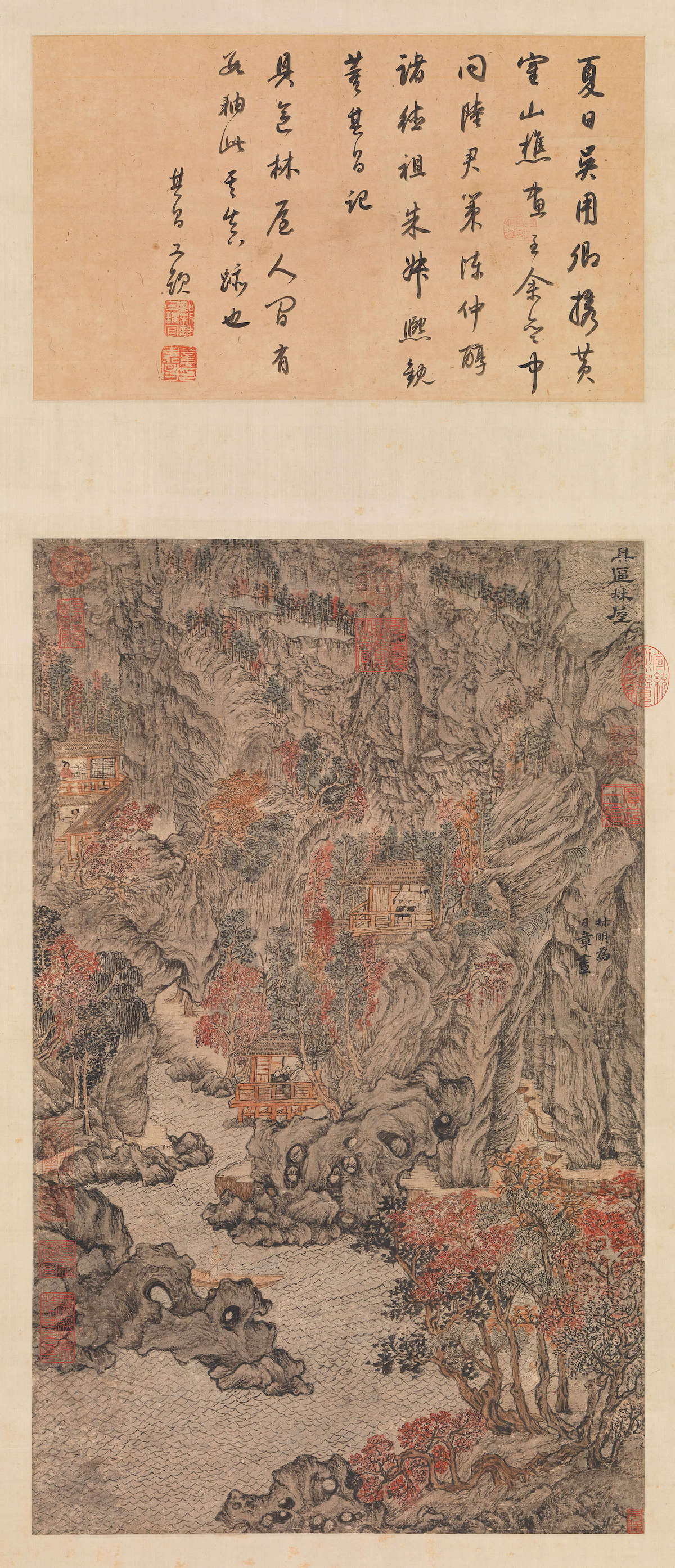
Yuanwang Mengju District Linwu Axis National Treasure First gear 10.5—12.25
"Guqu" is the ancient name of Taihu Lake, and "Linwu" is the forest house cave under the west mountain of Dongting in the middle of Taihu Lake. The stacked rocks are dry-rubbed with buffalo hair, presenting the special texture of lake rocks. The trees are dotted with ochre, garcinia, and cinnabar, and the autumn is colorful. Sparkling water, filling the room. Houses scattered on the dense composition, literati live happily among them. Wang Meng (1308-1385), courtesy name Shuming, nicknamed Huangheshanqiao, was the grandson of Zhao Mengfu (1254-1322). The four Yuan families in Wang Shizhen's mind were Zhao Mengfu (1254-1322), Wu Zhen (1280-1354), Huang Gongwang (1269-1354) and Wang Meng (1308-1385). He believes that Ni Zan is an excellent product and should not be included in the ordinary category. He pointed out that Wang Meng's painting style was strong and deep, and Chinese landscape painting changed again when Huang Gongwang and Wang Meng came, and influenced the paintings of Wu Di in the Ming Dynasty.

Tang Chu Suiliang, Yellow Silk Scroll of Lanting (part), first file 10.5—12.25
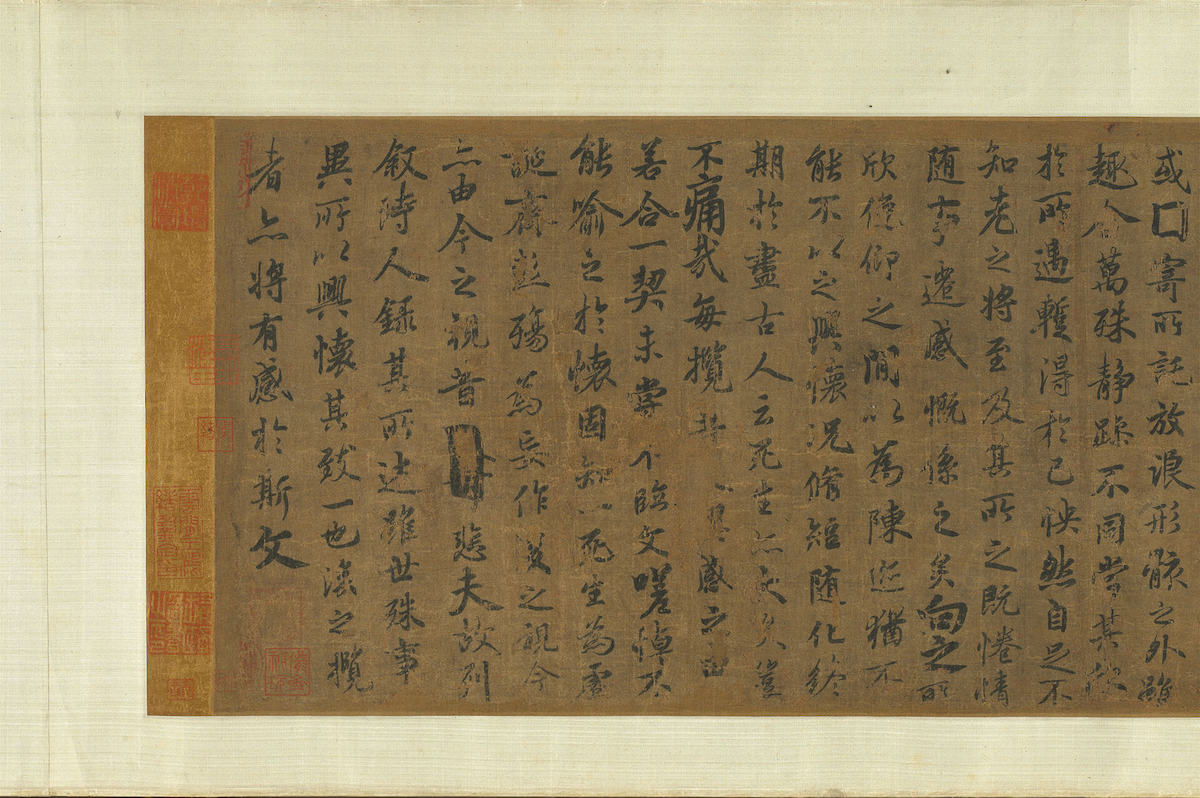
Tang Chu Suiliang, Yellow Silk Scroll of Lanting (part), first file 10.5—12.25

Tang Chu Suiliang Yellow Silk Ben Lanting Roll Rice Fu Postscript 1st file 10.5-12.25
In the history of calligraphy, Wang Xizhi's (303-361) book "Orchid Pavilion Preface" has always existed like a dream. It is said that Chu Suiliang (596-658), a calligrapher in the early Tang Dynasty, copied its original works, and many versions have been handed down. This piece is made of yellow silk, and the word "collar" in the text is from "ridge", reflecting the important characteristics of Chu Linben. Wang Shizhen bought this volume, and according to the inscription by Mi Fu (1052-1108) at the back of the volume, he wrote two long postscripts before and after, detailing the circulation process of this scroll, dialectically being the real work of Zhulin, and highly praised the calligraphy. Later, it was transferred to Japan and re-entered the "Lanqianshan Museum", which is now stored in the National Palace Museum in Taipei.

Song Huang Tingjian's Flowers and Intoxicating Posts Album National Treasures First File 10.5—12.25
Huang Tingjian (1045-1105), one of the four masters of the Northern Song Dynasty. This piece was commissioned in 1100, and the content is about 1087 to Wang Xu (after 1048-1104) of the seven unique poems. In the poem, he said that he was over middle-aged, and it was difficult for him to be in the mood to write poetry, but he was actually too modest. The full-action pen is vigorous and composed, the ink color changes from moist to dry, and the rules and regulations gradually become loose. Wang Shizhen once praised Huang's calligraphy for being "sloping and sloppy" and "having a good attitude", and said that this painting is "fairly old and well-structured", which is not a false accusation.

Tandoori Fu; Song Guozhida's Annotated New Published Annotated Du Poems Published by Guangdong Cao Si in the first year of Song Baoqing
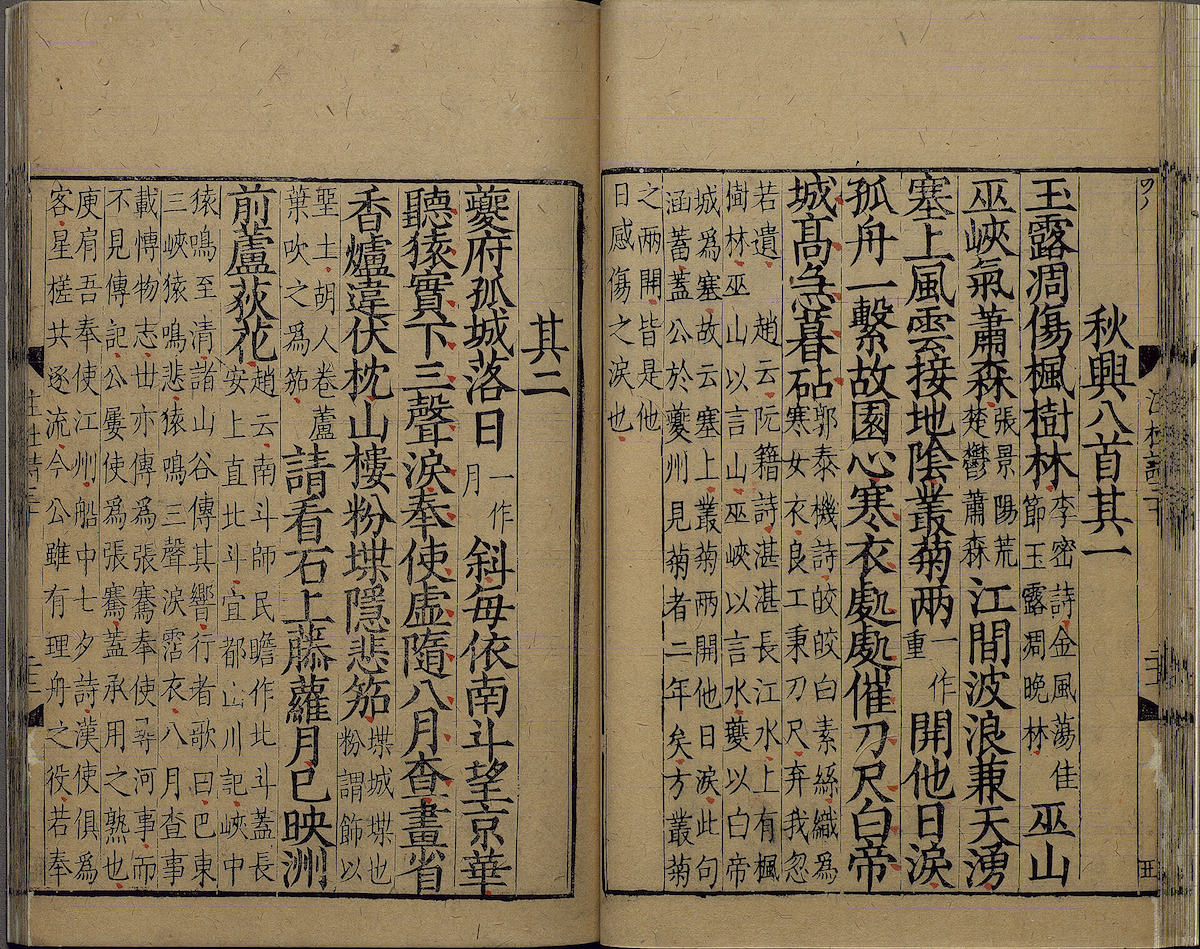
Tandoori Fu; Song Guozhida's Annotated New Published Annotated Du Poems Published by Guangdong Cao Si in the first year of Song Baoqing
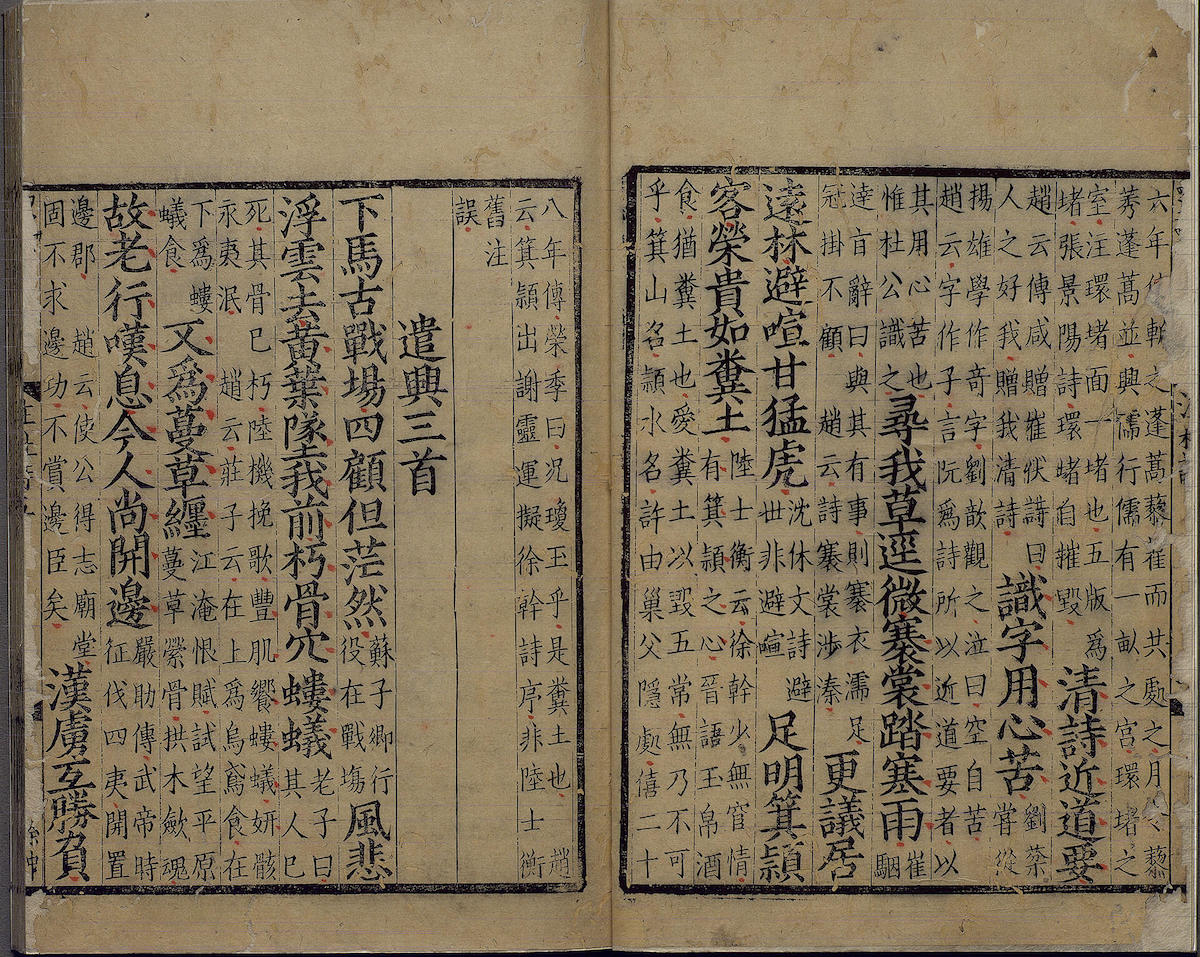
Tandoori Fu; Song Guozhida's Annotated New Published Annotated Du Poems Published by Guangdong Cao Si in the first year of Song Baoqing
The seven sons before and after the Ming Dynasty held high the banner of literary retro, "Writing must be Qin and Han, and poetry must be prosperous in Tang", and they tried their best to respect Du Fu and his poems, and their status was even higher than Li Bai. Wang Shizhen believes that Du Fu's seven-character rhythm poems have achieved the highest achievement, reaching the "sacred" realm; one of the "Eight Poems of Qiu Xing" is a scroll of the seven-character rhythm of the entire Tang Dynasty, and thus became the most enthusiastic writing of the calligraphers of the late Ming Dynasty. Du Poems. Wang Shimao's old collection of Song Dynasty Cao Si's block-printed "Newly published and calibrated Annotated Annotated Du Poems" is an earlier and relatively complete annotated version of Du Poetry in Song Dynasty. Cao Si's book has a magnificent opening, vigorous calligraphy and painting, and fine engraving. Song people's bibliography has been praised as "the most rare book", which can be said to be a collection of all Song Qinjia.
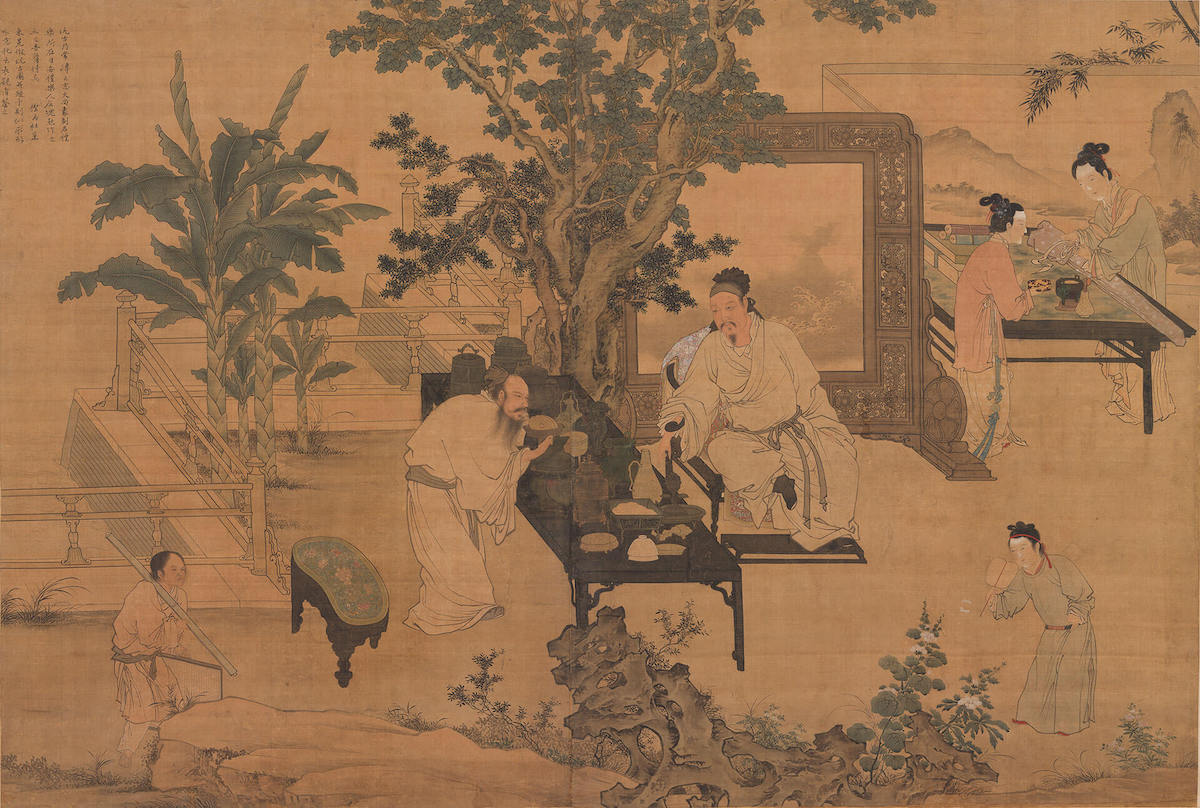
Mingdu Sumire Playing Ancient Figures Shaft (Part) National Treasure First Grade 10.5—12.25
The picture depicts the appreciation activities of scribes in the waterfront garden. The garden is elegantly furnished, and the long tables are covered with bells, dings, stoves, bowls and other various utensils. Wang Shizhen once praised Du Jin's (about 1465-1505) characters' pavilions as "Yan Ya with a deep ancient meaning", and this painting inherits the refined and elegant style of Southern Song Dynasty paintings.
The artist's inscriptions indicate that antiquity should be learned from the past and the present, and the system of ritual and music should be understood through research and identification of antiquities, as the basis for standing up and doing things. The works reflect the cultural atmosphere of Ming Dynasty literati who are fond of antiquity and good at collecting.
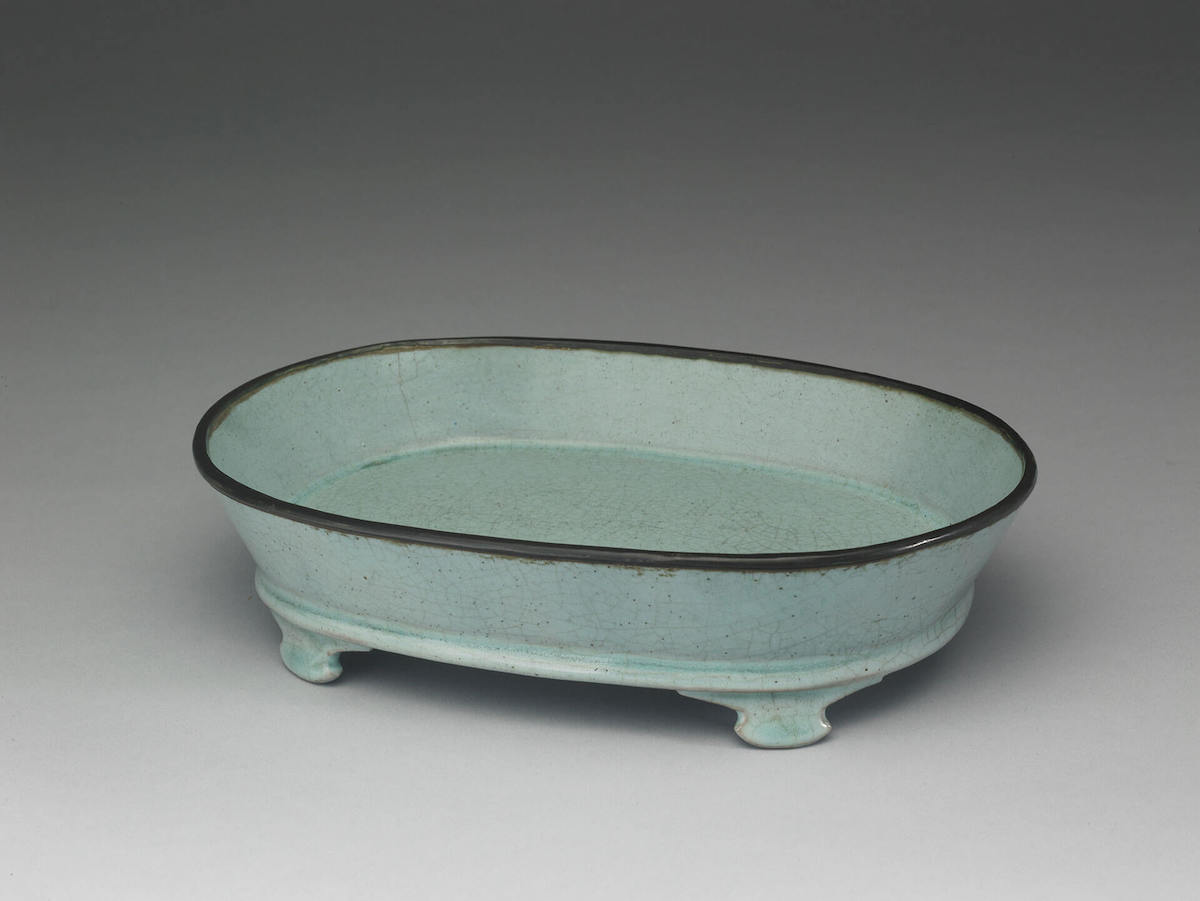
Northern Song Dynasty Ru Kiln Celadon Narcissus Basin National Treasure
The body of the narcissus pot is oval, with a flared rim, a copper button on the top, a flat bottom, and four legs under the narrow edge. The glaze color of the narcissus pot is bluish in the middle, and a faint pink light can be seen in the thin glaze at the turning point of the body. The surface of the vessel is covered with open pieces, and the outer bottom of the vessel has six sesame-shaped nail marks unique to Ru kiln porcelain. Wang Shizhen mentioned in his book "Gu Bu Gu Lu" on the rise and fall of the atmosphere of a generation: "The kiln should be the most important brother Ru", which clearly shows his high affirmation of Ru kiln porcelain in the Song Dynasty. The "painting is important to the Song Dynasty" mentioned in his book is quite consistent.

Ming Yongle sweet white cloud dragon pattern high foot bowl
The mouth of the high foot bowl is extravagant, with a deep wall and a high ring foot. The embryo is delicate, the bowl wall is thin, and the whole vessel is covered with a white and warm white glaze. The inner wall of the vessel has a conical arched cloud dragon pattern, and the heart of the bowl has a double-line four-character seal script mark of "Yongle Year System". Wang Shimao, the younger brother of Wang Shizhen, said in "Peeping the Sky and Outside the Vehicle": "...My dynasty was specially set up in Jingdezhen, Fuliang County. Between Yongle and Xuande, the firing of the inner palace has been expensive until now. At that time, the eyes were sweet and white. , decorated with Su Ma Liqing, and treasured with bright red." In particular, the sweet white porcelain fired in the Neifu during the Yongle period was highlighted, which was still cherished until the 16th century.
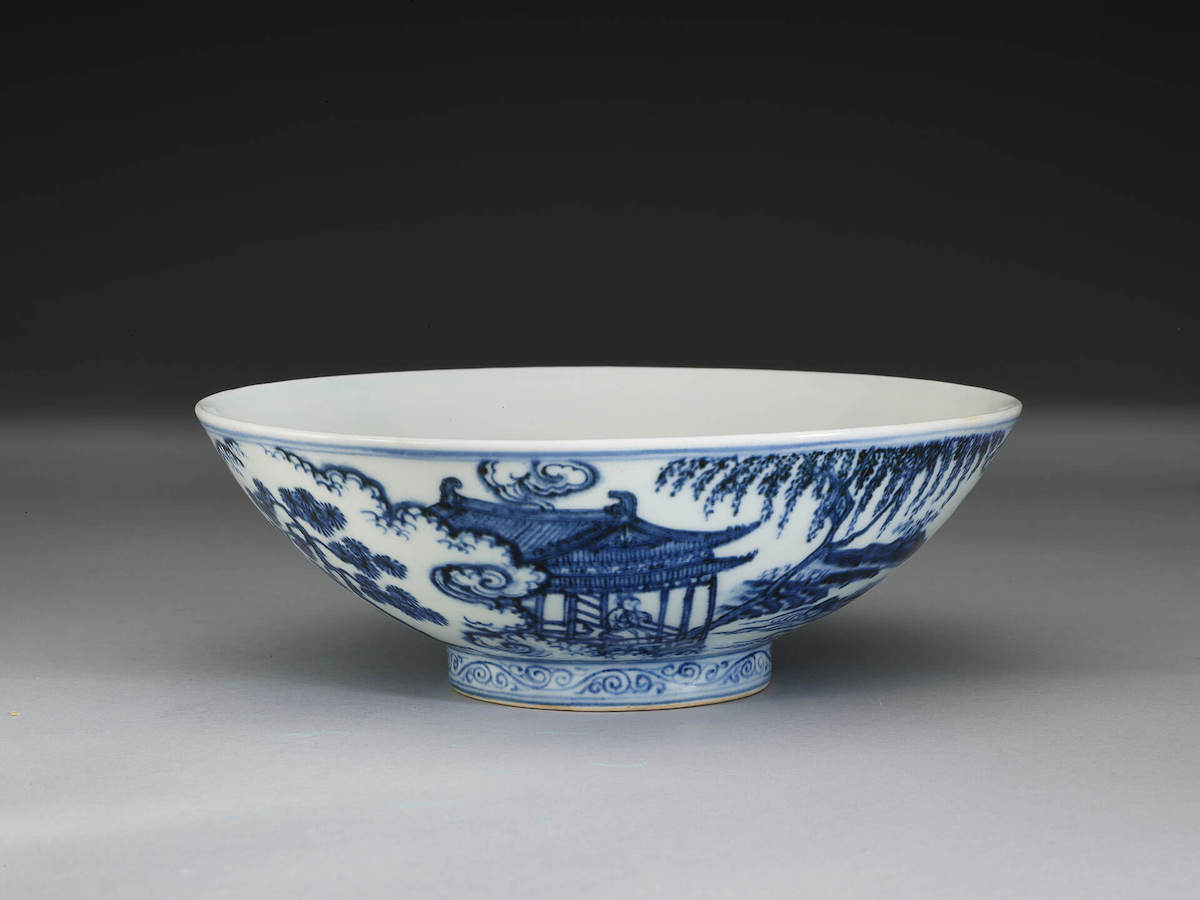
Ming Xuande blue and white ladies figure bowl
The bowl of the lady's picture is decorated with blue and white flowers. The outer wall of the vessel is between mountains and waters, trees and clouds, and two beauties are painted. One of them was playing a flute in the pavilion, and the other came across the phoenix in a volley. The outsole has double circles in regular script of "Daming Xuande Year System". The portrait of a lady is the first and most representative decoration on blue-and-white porcelain during the Xuande period. In addition to the flute and phoenix in this piece, there are also riding cranes, worshiping the moon, waterside pavilions and enjoying the cool, autumn evening poetry, and Begonia poetry. Wang Shizhen wrote in the "Gu Bu Gu Lu": "...In the past fifteen years, the promotion of virtue has been repeated, and even Yongle has become a city, and the price has also increased tenfold." It can be seen that porcelain during the Xuande period jumped into the mainstream of appreciation at that time, and reflected the market price.
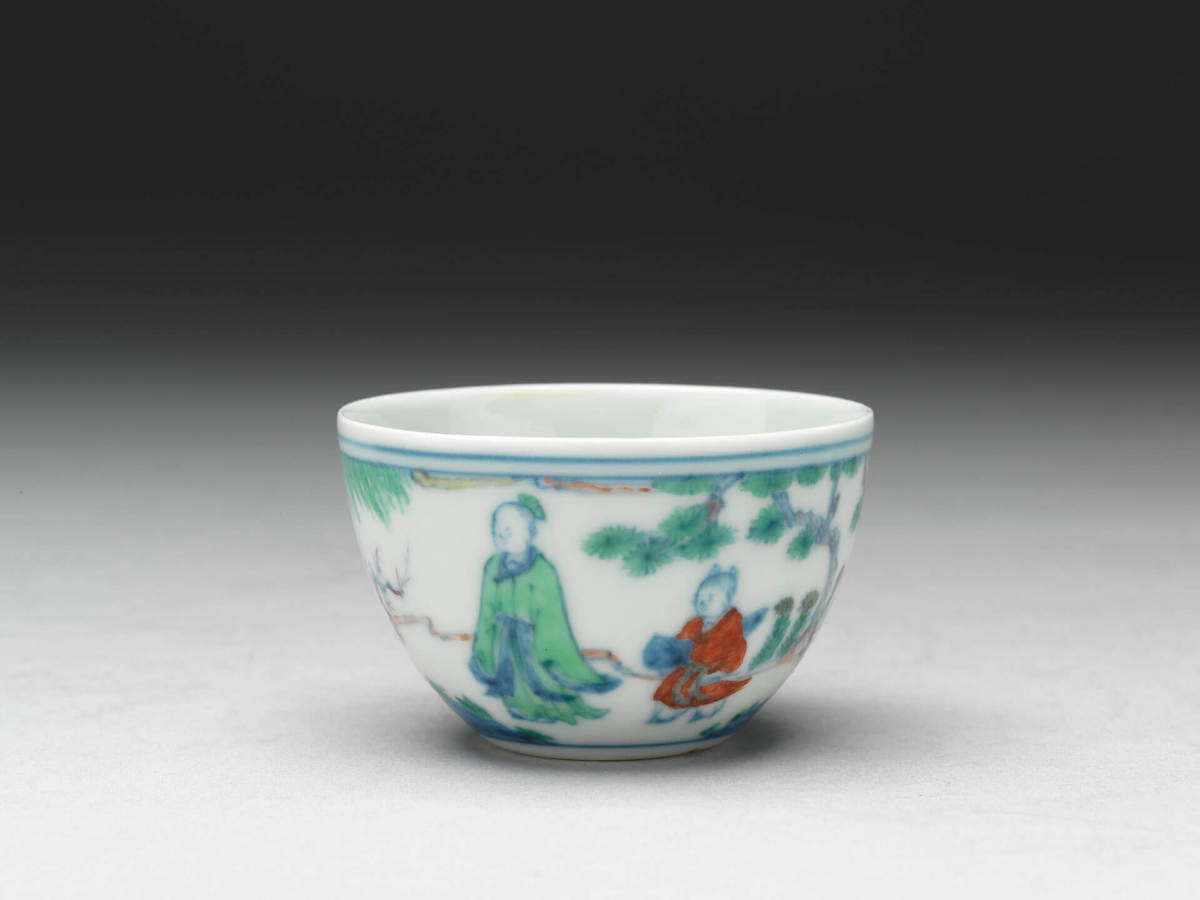
Ming Chenghua Doucai Figure Cup
This cup has a narrow mouth, a deep wall, and a shallow ring foot. The outer wall of the vessel is divided into two spaces by water and woods. One is a painting of a green-robed tall man and a boy in a red suit with a qin, standing under the pine trees in the forest; the other is a portrait of a man in a red robe sitting on the shore, watching the birds in the water with the boy in green clothes holding a book. The outsole of the device also has two-sided frames in blue and white regular script of "Da Ming Chenghua Year System". When Wang Shimao mentioned the works of the Chenghua period in Peering into the Sky, he specifically pointed out that "the burnt is still dazzling in five colors". It can be seen that the rich and colorful works were the primary objects for literati in the 16th century to appreciate the Chenghua utensils. The works of the Chenghua period were also at this time, and gradually compared with Xuande utensils, and were more sought after and appreciated.

Song Ren Kesi Xianshan Pavilion Album 2nd file 12.28—2023.3.21
In addition to being admired, kesi is also used as the head of a calligraphy and painting bag, to protect calligraphy and painting, and to help identify the types of works in the scroll. Wang Shizhen has seen a Kesi "Xianshan Pavilion", which is exquisitely crafted but not very interesting to draw. It is an old relic of the Song Dynasty. In this exhibit, weaving figures in pavilions, the composition is axisymmetric, and the weaving features are distinct, which is indeed different from the Kesi, which is similar to painting. Wang Shizhen also mentioned that at that time, new Kesi was used as an antique to seek high prices, but it is not difficult to distinguish. There is another Kesi in the National Palace Museum, Taipei. The composition is half a piece, with a pseudo inscription on the top, signed Yuan Dynasty Yu Ji (1272-1348). It seems that before and after Wang Shizhen's time, this kind of "Xianshan pavilion" Kesi was quite popular, and many were produced.

Song Zhu Kerou Wagtail Red Polygonum Album Important Antiquities Second File 12.28—2023.3.21
Wang Shizhen's "Four Manuscripts of Shanren in Yanzhou" mentioned that in the late Ming Dynasty, the newly-made Kesi was used as an old antique to obtain high prices. In addition to emphasizing the relationship with the ancient masters of painting to increase the value of Kesi calligraphy and painting, the Ming Dynasty also created a trend of chasing the famous Kesi masters of the Song Dynasty. It is now known that the Song Dynasty Kesi Weavers Zhu Kerou is the most famous, but also the most complicated. This work is the sixth page of the skeleton painting collection book. Eleven pieces of Kesi in the whole volume, ranging in size, are a collection. Among them, there are four woven and printed with "Zuke Flexo", with different appearances. The picture on this page has the imprint of Zhang Liu. Zhang was a famous framer and antique dealer in Yangzhou in the early Qing Dynasty. Perhaps this album was assembled or mounted by Zhang Liu.
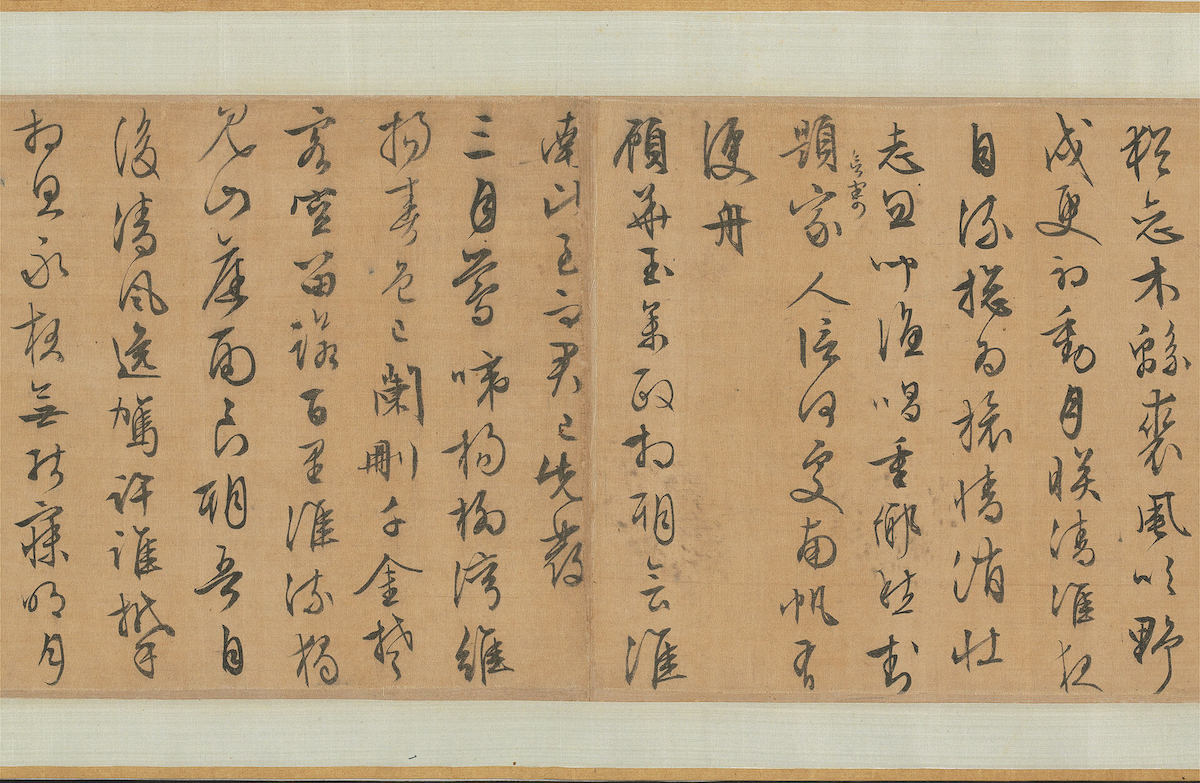
Ming Wen Zheng Ming's Self-Book Chronicle of Poems Volume (Partial) First File 10.5—12.25
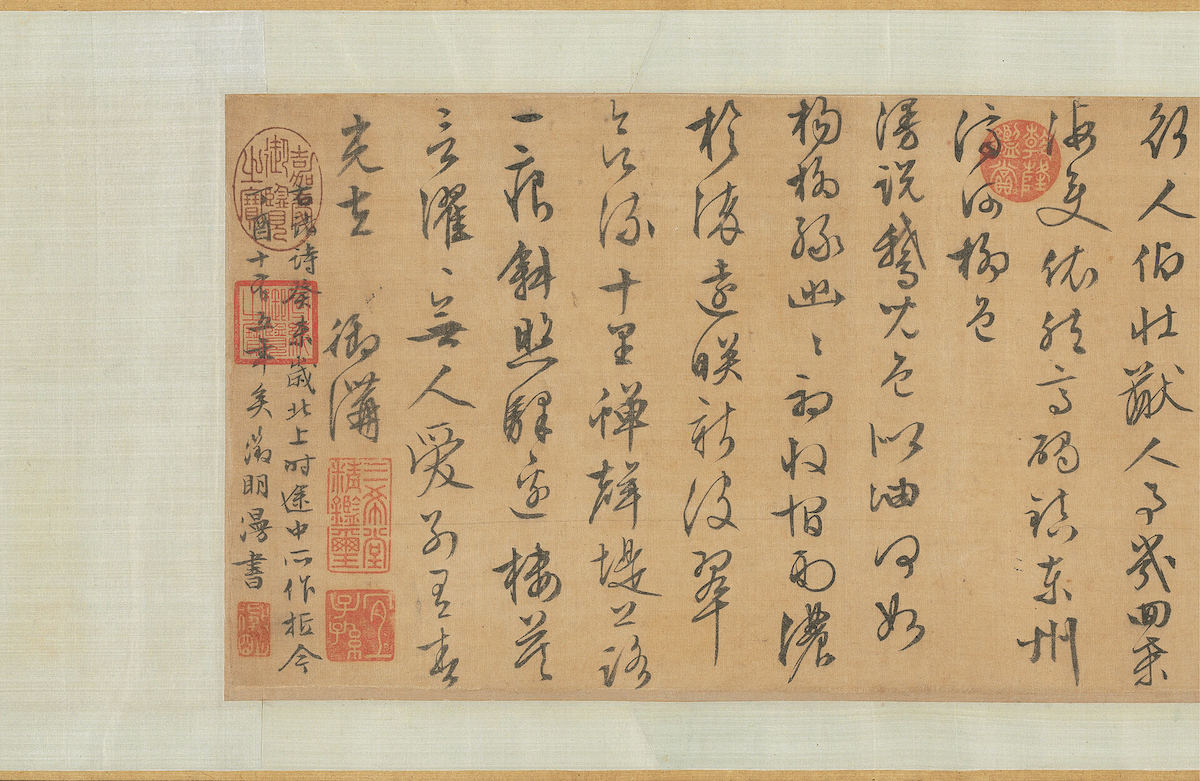
Ming Wen Zheng Ming's Self-Book Chronicle of Poems Volume (Partial) First File 10.5—12.25
Wen Zhengming (1470-1559), a native of Suzhou. Name wall, word Zhengming. Poetry, calligraphy and painting tools, also Jingjian collection, Suzhou literary leader, Wang Shizhen praised as one of the three best contemporary calligraphers.
This poem was written on the way to the capital, and it was written 15 years later. The use of the pen is vigorous and neat, meticulous, pays attention to the change of the brush stroke, the body is tightly knotted, and the brushwork is continuous and colorful. Due to the large number of followers, Wen Zhengming's cursive style has also become the most representative style of the era.
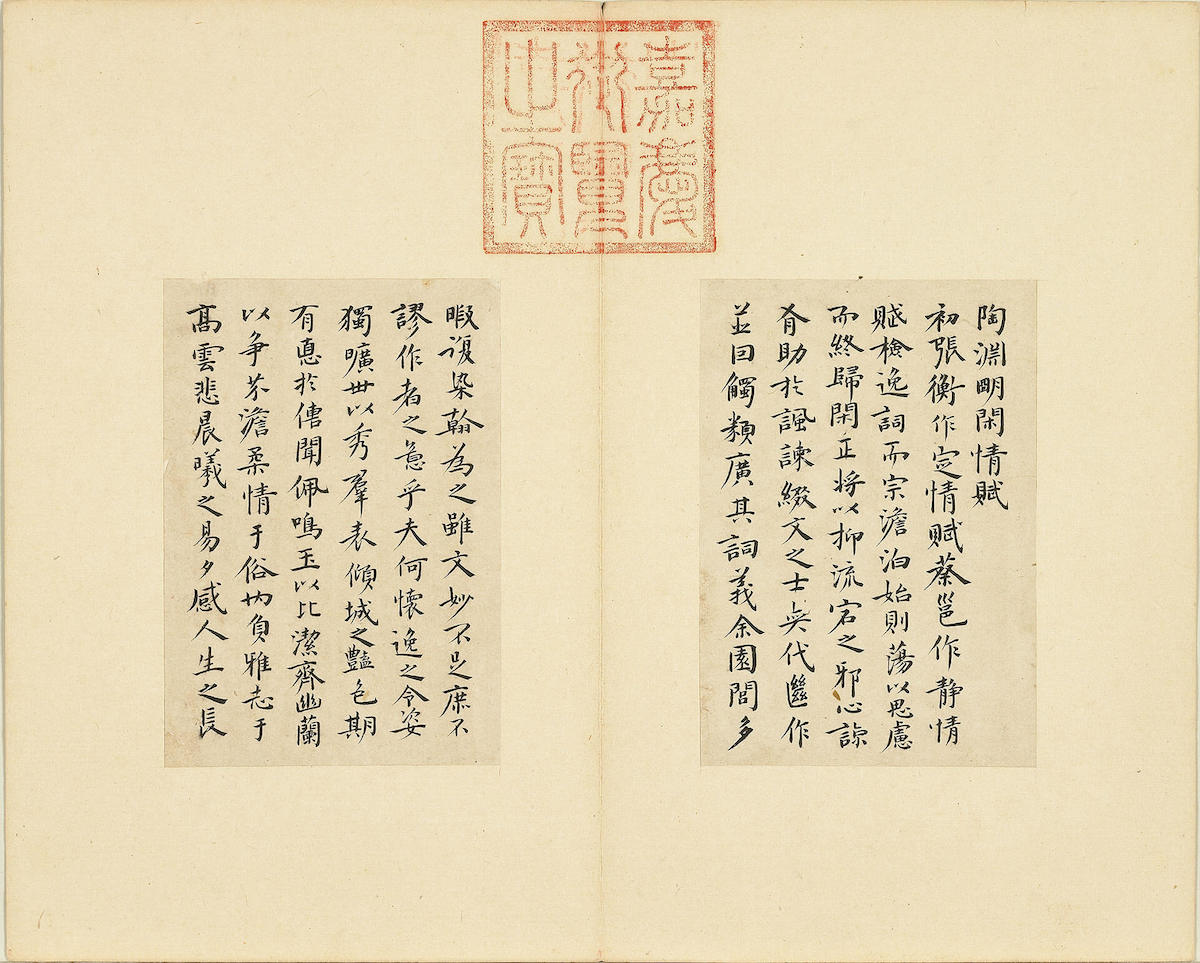
Ming Zhu Yunming Book Tao Yuanming's Leisurely Love Album Book 212.28—2023.3.21
Wang Shizhen believed that among the calligraphy circles of the Ming Dynasty, the most outstanding ones were Zhu Yunming (1461-1527), Wen Zhengming (1470-1559) and Wang Chong (1494-1533), and the point of view of the three schools of Wuzhong is still the mainstream in the history of calligraphy. statement.
This book is neat and delicate, the lines are moist and condensed, round and thick with an elegant temperament, and the words are full of ingenuity. Skimming, pressing, horizontal and vertical, often stretch vertically and horizontally, playing a unified effect. This volume is unique in style, showing an uninhibited personality, representing his extraordinary achievement in small letters.
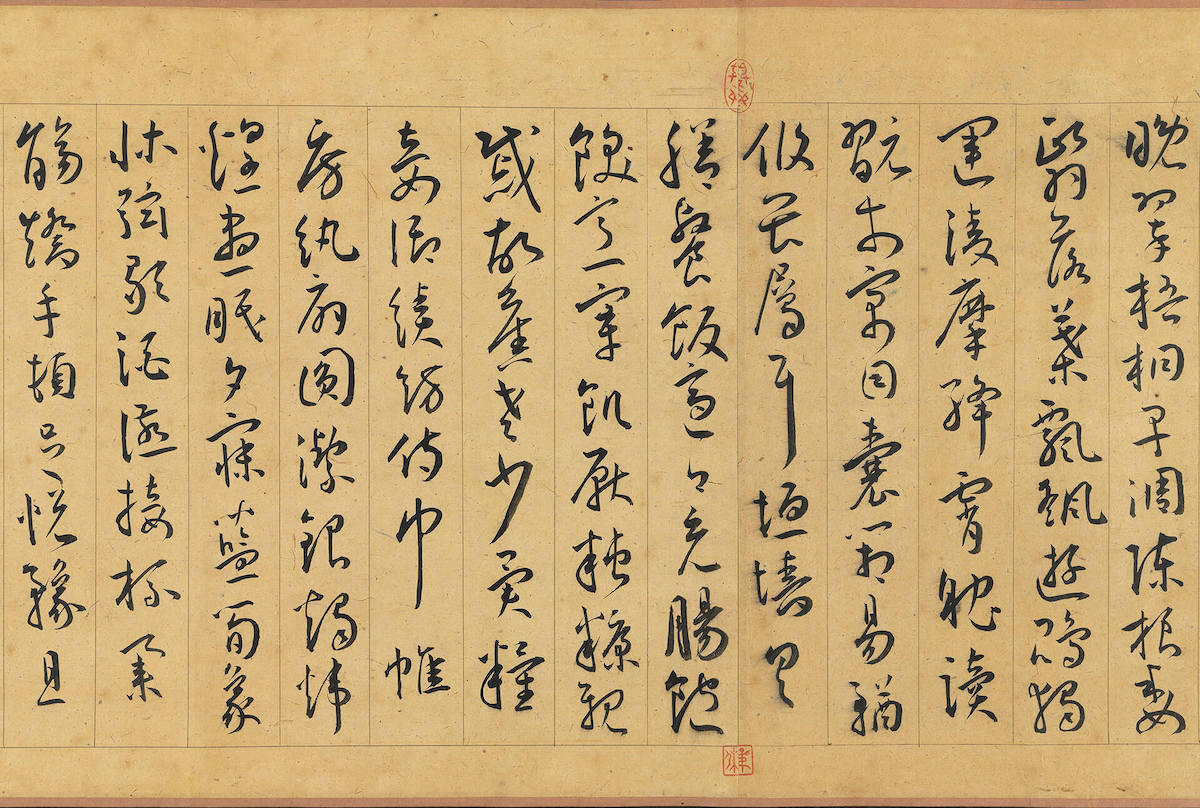
Ming Wang Chongqianwen Volume (Part) Second file 12.28—2023.3.21
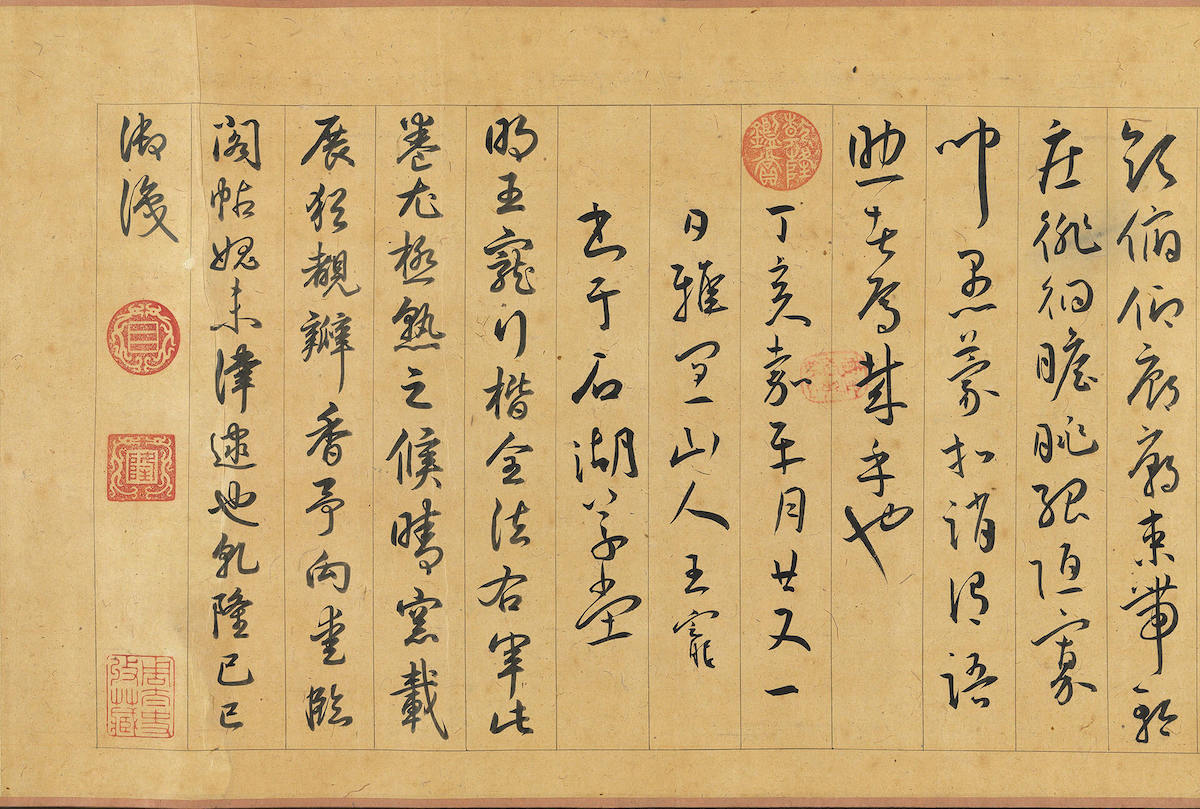
Ming Wang Chongqianwen Volume (Part) Second file 12.28—2023.3.21
Wang Chong (1494-1533), courtesy name Lvji, was a native of Suzhou. He was only forty years old when he died, and was hailed by Wang Shizhen as one of the three best contemporary calligraphers.
The style of calligraphy originated from Wang Xizhi (303-361) and Yu Shinan (558-638), but contemporary Zhu Yunming (1461-1527) and Cai Yu (?-1541) had a greater influence on him. The layout of this cursive script is sparse and simple, with a simple and innocent style. Although it looks plain at first glance, the characters and strokes are quite varied, with their own sparse and elegant characteristics.
The grand occasion of multiple competitions between classes and regions
After the death of Wen Zhengming (1470-1559), Wang Shizhen became the leader of appreciation in the Suzhou area. At that time, there were also many connoisseurs in various places in the late Ming Dynasty, such as Jiaxing Xiang Yuanbian (1525-1590), Xin'an Wang Daokun (1525-1593), Zhan Jingfeng (1528-1602), Songjiang Mo Shilong (1537-1587) and others. Some of these people are wealthy people, some are local gentry or commoners, they come from different classes and regions, and they have deep financial and appreciation ability, and they are challenging the authority of Suzhou art and literature appreciation. This unit especially presents the grand occasion of collectors all over the south of the Yangtze River with numerous collections, and also witnesses the competition and cooperation between Wang Shizhen and them. In the early Qing Dynasty, it was recorded that Wang Shizhen took many Suzhou artists to visit Huizhou, and held several rounds of talent competitions with local talents. Regardless of whether such a grand literati meeting was actually held, the rumors themselves clearly describe the co-opetitive relationship between Suzhou literati and Huizhou businessmen. At the end of the rumor, Huizhou talent seemed to have won because he was recognized by Wang Shizhen. However, this result further showed Wang Shizhen's authority as a leader of art and literature and a judge of the level of talent at that time.

Western Han Dynasty Xiang Yuan Bian Ming Yu Chan
The jade cicada in the Han Dynasty was originally a jade placed in the mouth of the great nobles in funeral ceremonies, in order to pray for the meaning of feathering and rebirth, and later generations changed its use and added perforations that can be tied. Inscribed seal characters on the front and back: "Jin Zhangzong's royal inscription on Jin Youjun general Wang Xizhi's original work of looking at the near-Longbao post, and the secret reward of Xiang Yuanbian, a man from Molin Mountain in the Ming Dynasty." Jin Wang Xizhi (303-361) in the inscription of Sanxitang in the courtyard "Zhan Jin Tie Long Bao Tie" has an inscription and postscript in the year of Ouyang Xuanzhi Zheng Ding You (1357), which mentions that the sticker of the thin gold body is imitated Xuan Xuan and calligraphy of Jin Zhangzong (1189-1208). Xiang Yuanbian (1525-1590), a native of Jiaxing, was a famous collector in the late Ming Dynasty. This post also has the stamp of Xiang's collection, so it can be seen that the records recorded by Yuchan are related to the collection of legal posts in the Ming Dynasty.
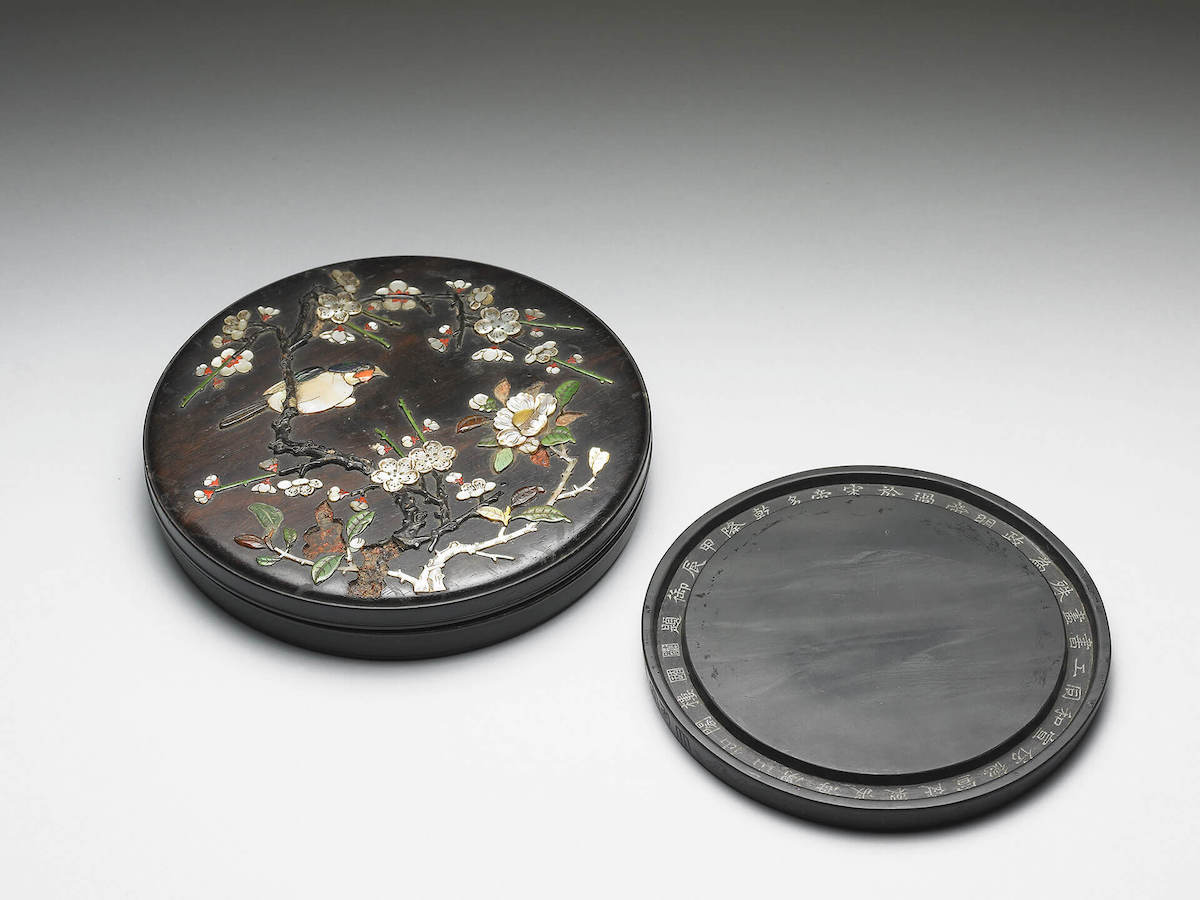
Ming She Inkstone with Zhouzhu Mark Hundred Treasures Inlaid Inkstone Box
A round inkstone, with an inkstone pool in the outer ring, imitating the style of the Biyong inkstone. Anhui Sheshi, with delicate material and ink, is an antique inkstone in the late Ming Dynasty. The inkstone is attached to a wooden box, inlaid with luotian and dyed lacquer, wood, bone, and horn pieces to form a colorful picture of flowers and birds, with a magpie perched on the head of a plum stem, and a toon flower under the tree. The bottom of the box is inlaid with silver wire to form a square seal of "Wumen Zhouzhu" in four seal characters. In the late Ming Dynasty, the inlaid pictures with various colors of gemstones, corals, horns, snails, lacquer wood, and miscellaneous inlaid pictures were called "Hundred Treasures Inlays". The famous craftsmen who were best at this skill in the Jia and Wan periods were named Zhou. And Zhang Dai's book "Tao'an Dream Recollection" is Zhou Zhu, who praised it as "Wuzhong's stunt".
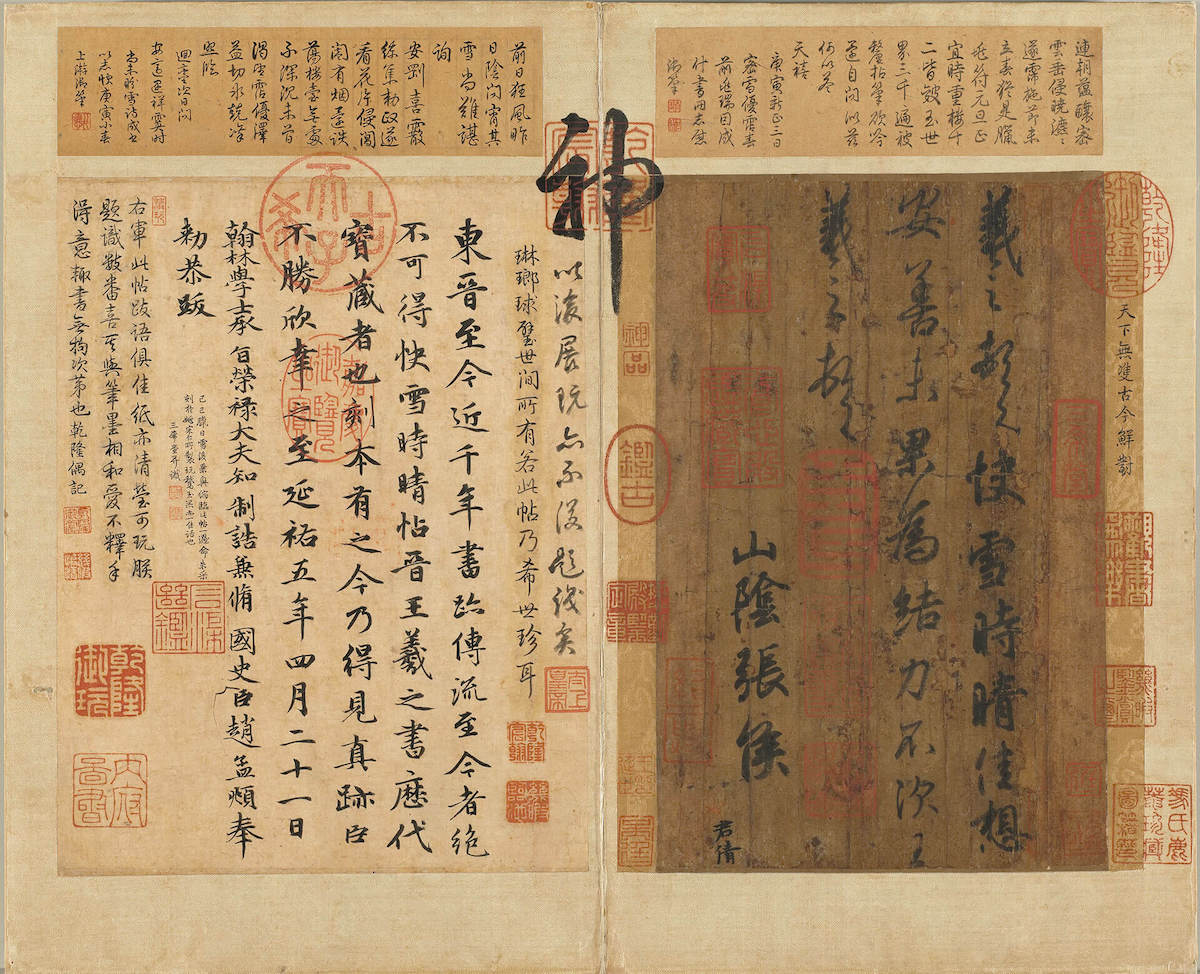
Jin Wang Xizhi's Posts on Fast Snow and Clear Time Booklet National Treasure 2023.2.8—3.21 (Exhibition only)
According to the inscription, the painter surnamed Lu sold it to Wang Sudeng (1535-1614), which later became the collection of Liu Chengxi (?-1662). After Wang Yan's death, with the help of his father and son Xu Jie (1503-1583), Liu Chan (1504-1563) and Liu Shouyou, he was restored to his official rank. Wang and Liu have an extraordinary friendship, and Liu Chengxi is also the publisher of the first engraving of "Jin Ping Mei", which shows the special relationship between the two. "Quick Snow and Clear Time" was originally written by Wang Xizhi (303-361). Since the original work is not passed on, this Tang copy has become a precious script. It is also one of the three treasures collected by Emperor Qianlong (1711-1799). Cultural and artistic value.
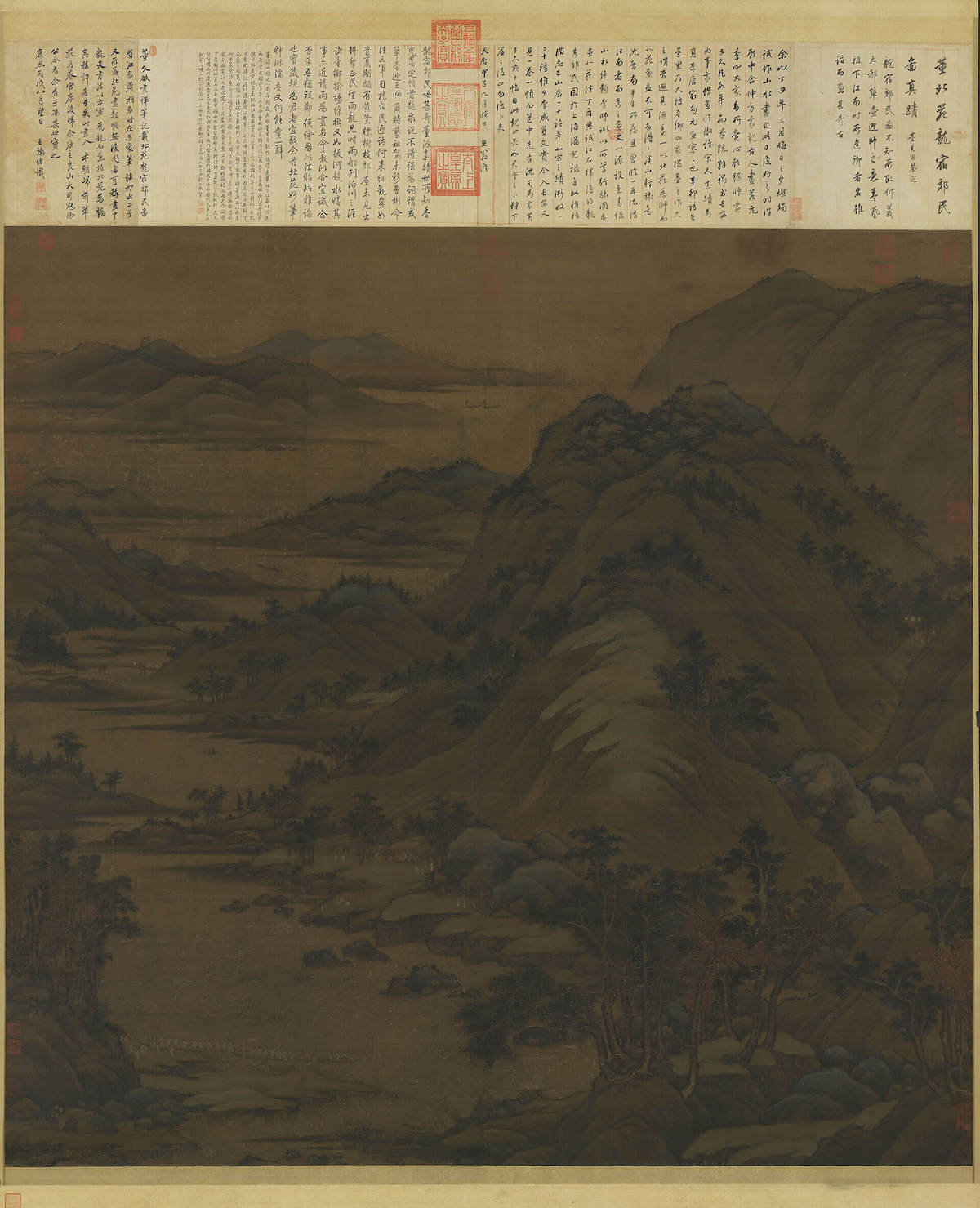
Five Dynasties, Southern Tang Dynasty, Dongyuan, Longsu Suburbs, Axis, National Treasure, 10.5—11.15 (Exhibition only)
Dong Yuan (?—about 962), who was good at painting Jiangnan landscapes, had a profound influence on later literati paintings. The painting is taken from a bird's-eye view, and the cascading mountains are drawn with the method of draping the hemp and moss, and the trees are lush and vigorous.
Dong Qichang (1555-1636) approved it as "Dongbeiyuan Longsu Suburbs. Authentic." From the postscript, it can be seen that Ding You (1597) Dong of Wanli obtained this painting in Pan Guanglu, who was the third son of Pan Yunduan (1526-1601). Songjiang painting and calligraphy connoisseur Mo Shilong (1537-1587) was the son-in-law. In addition to collecting famous Song and Yuan masters, Mo Shilong is also the founder of the theory of landscapes in the northern and southern sects. This work should be a collection of relics by Mo Shilong, and it can also be seen that Songjiang party respects and attaches great importance to Dong Yuan.
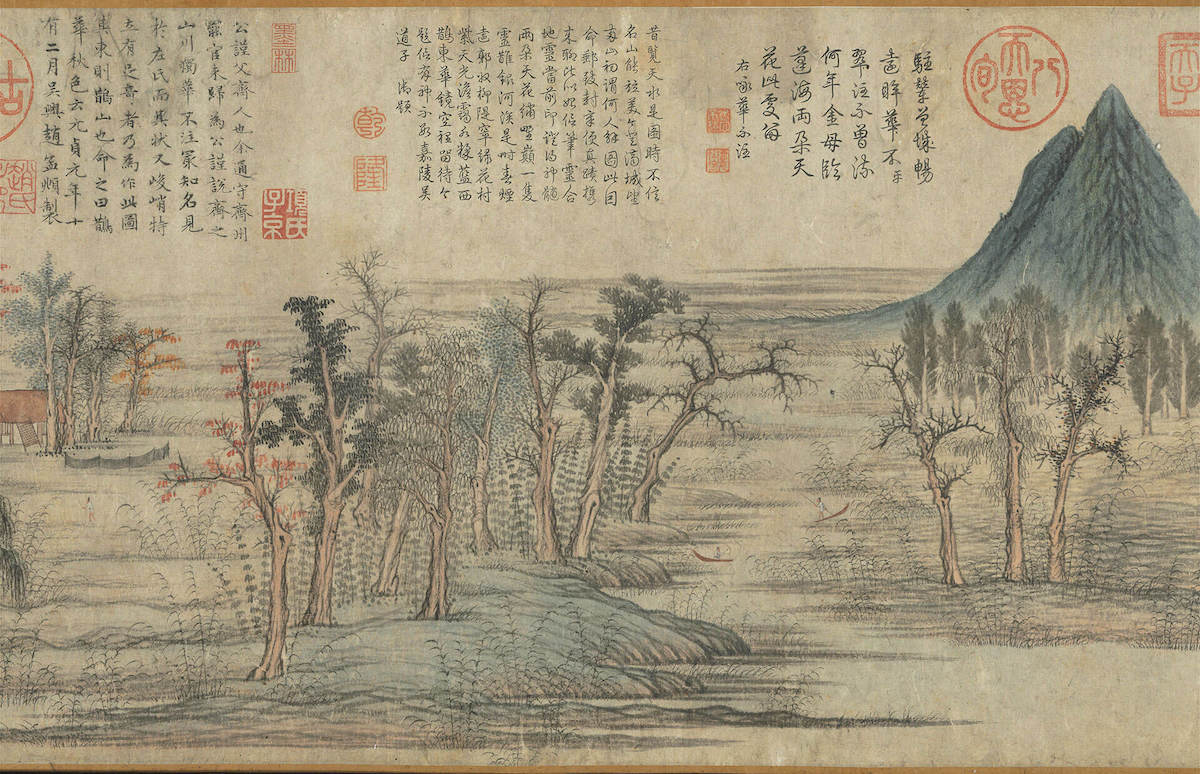
Yuan Zhao Mengfu Magpies and Flowers in Autumn, Volume National Treasures 10.5—11.15 (Exhibition only)
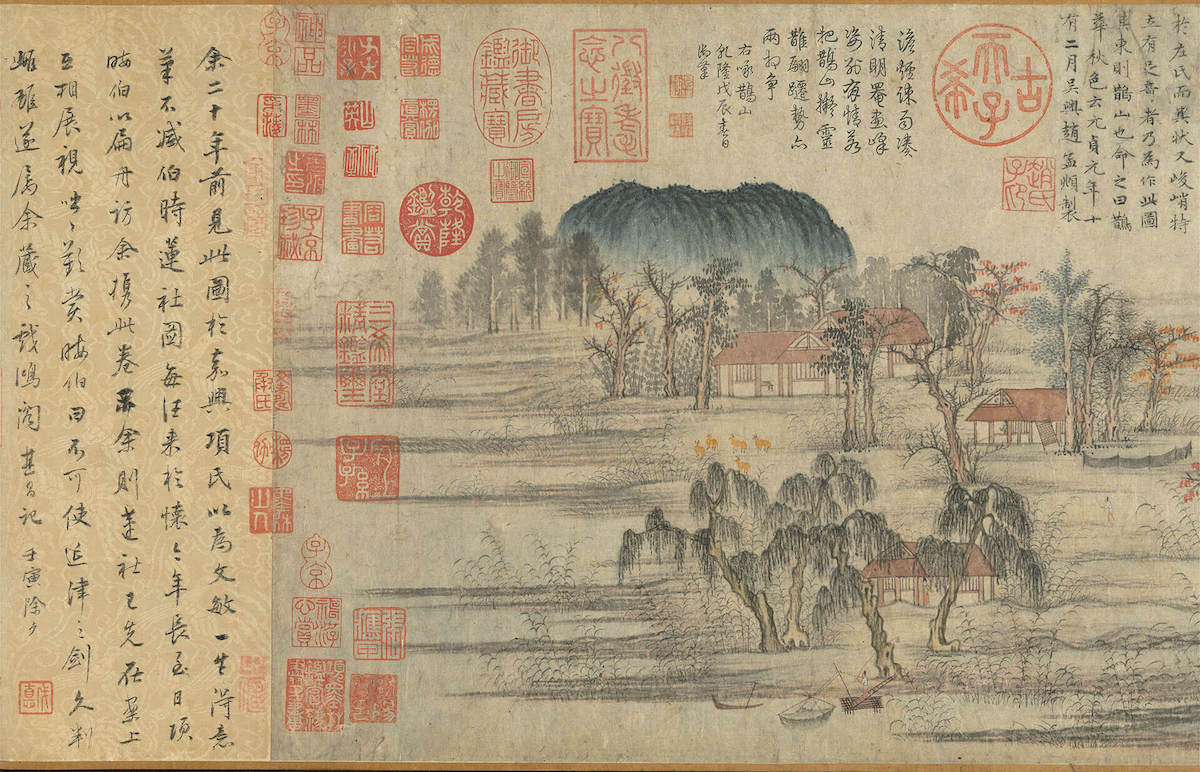
Yuan Zhao Mengfu Magpies and Flowers in Autumn, Volume National Treasures 10.5—11.15 (Exhibition only)
Wang Shizhen and Xiang Yuanbian (1525-1590) were both proficient in the appreciation of calligraphy and painting, and they disagreed with each other. Shen Defu (1578-1642) called the king a "great appreciation" in his "Wanli Wilderness Compilation". Wang Shizhen believed that Xiang Yuanbian (1525-1590) had poor eyesight, and could only use a lot of money to seize the famous paintings. Xiang Yuanbian told Zhan Jingfeng (1528-1602) that Wang Shizhen's brothers were blind men, and only Wen Zhengming (1470-1559), who had worked for a long time, had two eyes, and now only he and Zhan are the giants in the collection. This work was painted by Zhou Mi (1232-1298) by Zhao Mengfu (1254-1322) in 1295. The first section is Huabuzhu Mountain, the last section is Magpie Mountain, and the middle section is in front of a large area of water. Fisherman, creating a tranquil and peaceful atmosphere.

Ming Chouying imitates General Li Haitianxia Photo Vol. 2nd file 12.28—2023.3.21
The heavy green and green landscapes shimmer in the afterglow of the sunset, like a fairyland. At the back of the volume, there are postscripts by Wu Kuan (1435-1504) and Wen Zhengming (1470-1559), which are called Xiang Yuanbian (1525-1590) and Tuo Qiuying (about 1494-1552) imitating Li Zhaodao (675-758). . When Wu Kuan died, Qiu Ying was at most ten years old, and Xiang Yuanbian was not yet born, so this inscription and painting are fake. According to Wang Shizhen's records, Yan Shifan (1513-1565), through a prefect, plundered a volume of Li Zhaodao's "Falling Photos of the Sea and the Sky" from the Tang family in Wucheng. The Tang family once asked Qiu Ying to copy a copy, which was later sold to Wang Shizhen. At that time, there were many such fake works of green landscapes circulating in the world. Although the title of this painting is Haitianxiazhao, it may be used to imagine similar works collected by Wang Shizhen.
Leading the trend to define prosperity
As a leader in the art and literature circles at that time, Wang Shizhen drove many emerging trends and defined contemporary prosperity. He loves gardens, and he invested a lot of assets in the construction of gardens in his life. He wrote the texts of appreciation and appreciation for the gardens and the garden drawings, which further contributed to the production of garden paintings. Along with the travel trend, he pioneered traveling with painters and produced Jiyou albums with different styles and meanings. This is an example of the specific influence of sponsors on artistic creation, and it has become a precedent for similar paintings in the Qing Dynasty. When it comes to the Compendium of Materia Medica, which no one knows about today, it was published only after he received his approval and wrote a preface for it. Wang Xijue's daughter Tan Yangzi, because of Wang Shizhen's strong recommendation, her faith quickly prevailed. The "Biography of the Queen Mother of the West", which was written under his name, made the image of the Queen Mother of the West more widely circulated. This unit, through the trend brought by Wang Shizhen, clearly reflects the grand occasion of his "prosperity and spirit covering the world" and the spirit of prosperity defined by him.
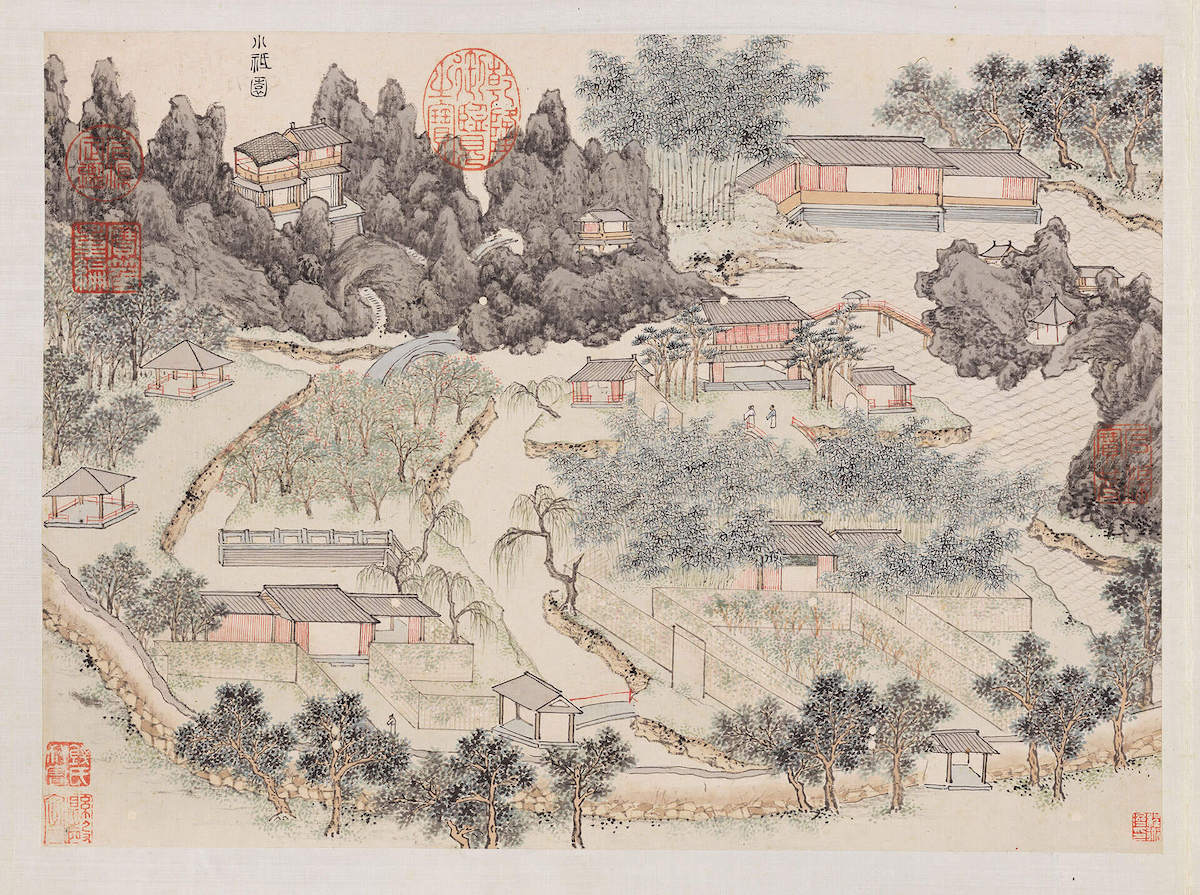
Mingqian Valley Travel Map Album
This set of albums was originally ordered by Wang Shizhen to record what he saw during his trip to Beijing in 1574. However, Qian Gu (1508-1578) seemed reluctant to travel far, and only painted the scenery of the waterway from Wang Shizhen's Xiao Gion to Yangzhou. There are 32 albums in total, which are almost the same as the first volume of "Qian Gu Zhang's Composite Paintings of Water Courses" in the National Palace Museum in Taipei, but the tone is more elegant and elegant. It may be a copy made by Qian Gu. Qiangu, courtesy name Shubao, was born in Wuxian, Jiangsu. Young orphaned and poor and dropped out of school, he later traveled to Wen Zhengming's door. He is good at landscape, orchid and bamboo, and often painted for Wang Shizhen in his later years. Wang Shizhen also wrote biographies for Wu painters such as Qian Gu and Lu Zhi (1496-1576), and treated them with courtesy.

Mingqiangu and Zhang's composite painting of water process map album
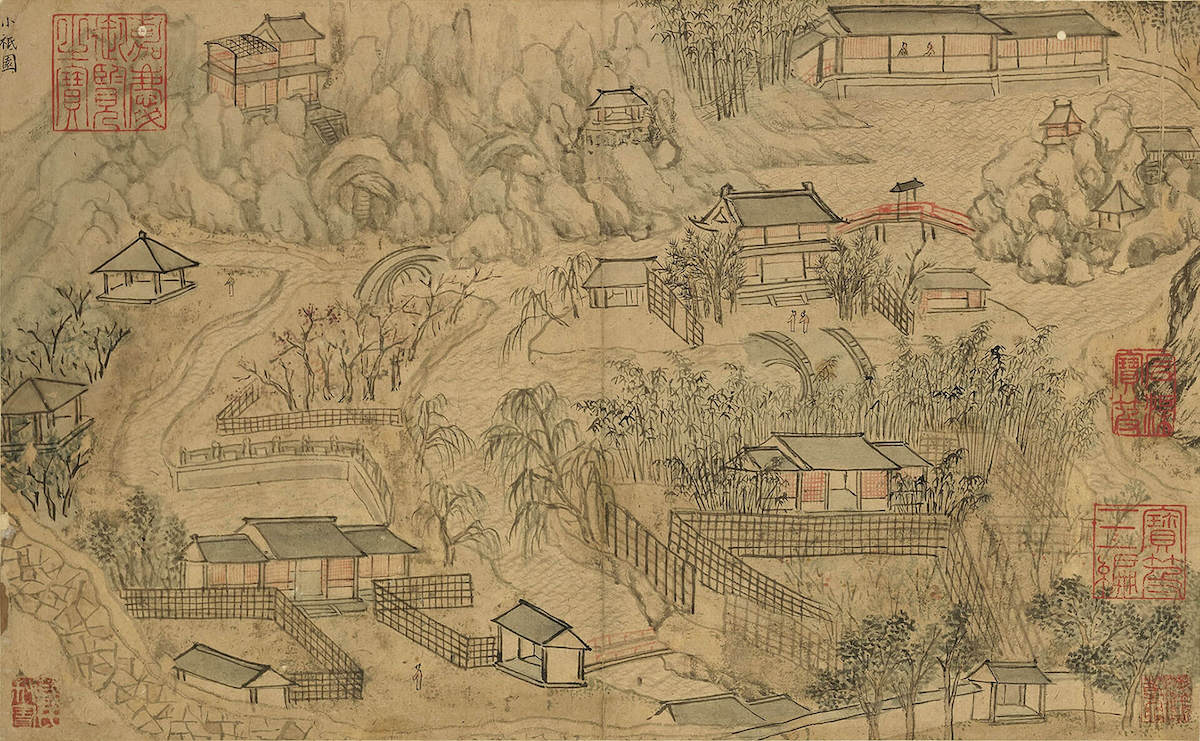
Mingqiangu and Zhang's composite painting of water process map album
This set of atlas is divided into three volumes, upper, middle and lower, with a total of 84 pictures, and two back subpages with inscriptions and inscriptions. It was commissioned by Wang Shizhen to paint by Qian Gu (1508-1578) and Zhang Fu (1546-1631). According to the inscription, this is an image record of Wang Shizhen entering Beijing from his hometown via the Grand Canal in the second year of Wanli (1574). The first 32 openings were drawn by Qian Gu on the road from Xiaogion Garden to Yangzhou; the latter 52 openings were painted by Zhang Fu accompanying Wang Shizhen on the way north, and then handed over to the teacher Qian Gu for polishing. The content of the album is different from the traditional pictures of scenic spots. In addition to the coastal scenery, there are also administrative organs and river facilities that have not been painted before. It is a documentary image under the guidance of Wang Shizhen, and it also reflects Wang Shizhen's attempt to preserve history.

Ming Tic Red Eight Immortals Celebrating Longevity Character Pen Holder
Cylindrical pen holder with thick lacquer, deep red and moist lacquer, on the brocade ground, there are repeated engravings of bushes, clouds and figures. In the middle of the pen holder is the Eight Immortals, headed by Zhang Guolao, holding a longevity peach in his hand, dedicated to the Queen Mother of the West above. The Eight Immortals is a popular auspicious theme in the late Ming Dynasty. Celebrating the birthday of the Eight Immortals is an indispensable theme in operas since the Song and Yuan Dynasties. However, it is rare to see the Eight Immortals and the Queen Mother of the West appearing at the same time. Here, the Queen Mother of the West sits cross-legged on top of a phoenix bird, holding a ruyi in hand, with a maid in front and a maid in the back. She descends from the sky and greets the Eight Immortals, celebrating and lively. It is a work that integrates literati culture and popular culture.

Ming Gu Embroidery Eight Immortals Celebrating Longevity Hanging Screen (11) Xichi Queen Mother Shaft (Partial) First gear 10.5—12.25
This picture is one of the twelve scrolls of the Eight Immortals Celebrating the Birthday Celebrations, with color embroidery of the Queen Mother of the West Pond on the ground. In addition to the Eight Immortals, the whole series also includes the Queen Mother of Xichi, the Antarctic Immortal Weng, and the Hehe Immortals, each embroidered with a immortal.
An image of the Queen Mother of the West was published in The Complete Biography of Youxiang Lie Xian, written by Wang Shizhen under the name of Wang Shizhen. In this work, the Queen Mother is separated from the image of the combination of humans and beasts, but instead has the appearance of a graceful and elegant goddess. The Queen Mother descended from the sky on a phoenix, with the maid by her side, surrounded by auspicious clouds, and her clothes were flying. The whole embroidery is exquisite and exquisite. The phoenix tail is dyed first and then embroidered. The combination of embroidery and painting has a novel effect; Queen Mother image.
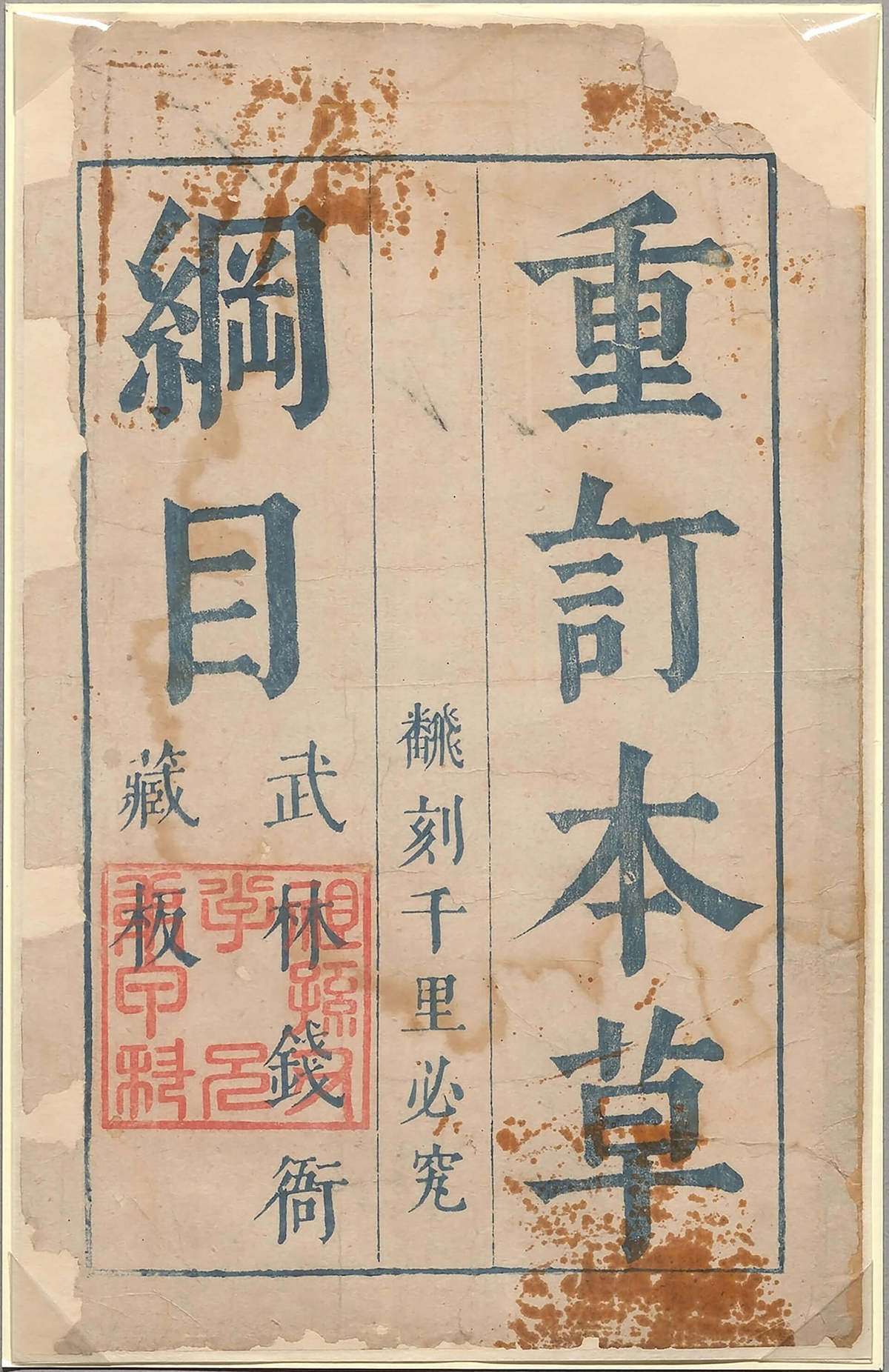
Ming Li Shizhen's Compendium of Materia Medica, published by Qian Weiqi in the thirteenth year of Ming Chongzhen, the first file 10.5—12.25
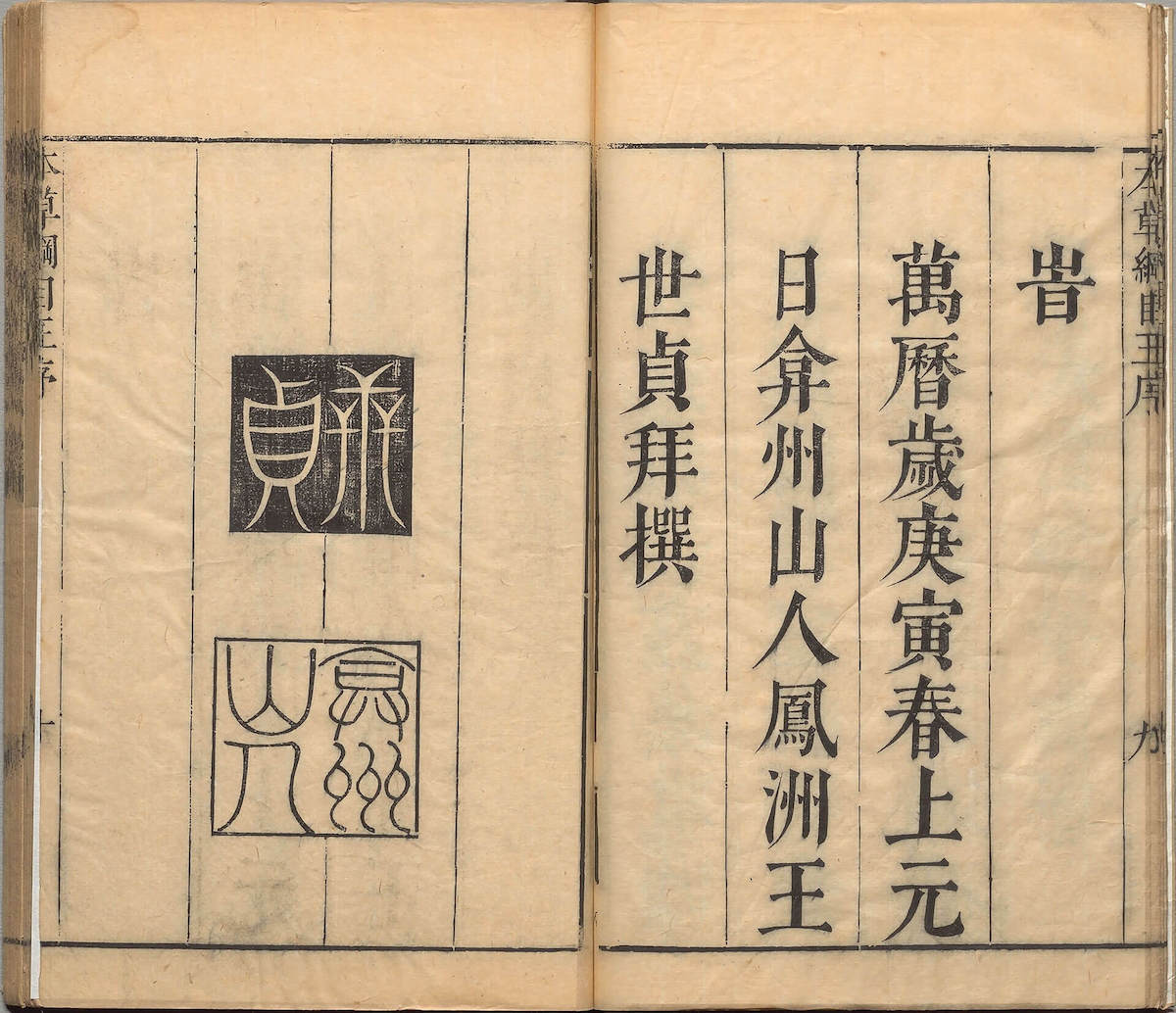
Ming Li Shizhen's Compendium of Materia Medica, published by Qian Weiqi in the thirteenth year of Ming Chongzhen, the first file 10.5—12.25
"Compendium of Materia Medica" is a masterpiece of pharmacology completed by Li Shizhen, a Ming Dynasty pharmacologist, on the basis of the past dynasties of Materia Medica and with personal investigation. At the beginning of the book, Li Shizhen asked Wang Shizhen, a literary leader at the time, to write a preface to the book; however, Wang Shizhen saw the inadequacy of the manuscript, so he brought the book back for revision. Ten years later, Li Shizhen visited Wang Shizhen again with the carefully revised Compendium of Materia Medica. Wang Shizhen was very satisfied with this and happily wrote the preface. With the recommendation of Wang Shizhen's preface, Nanjing booksellers rushed to publish the Compendium of Materia Medica with Wang Shizhen's preface. Finally, the book was engraved and published by Hu Chenglong, a Nanjing bibliophile and bookseller.
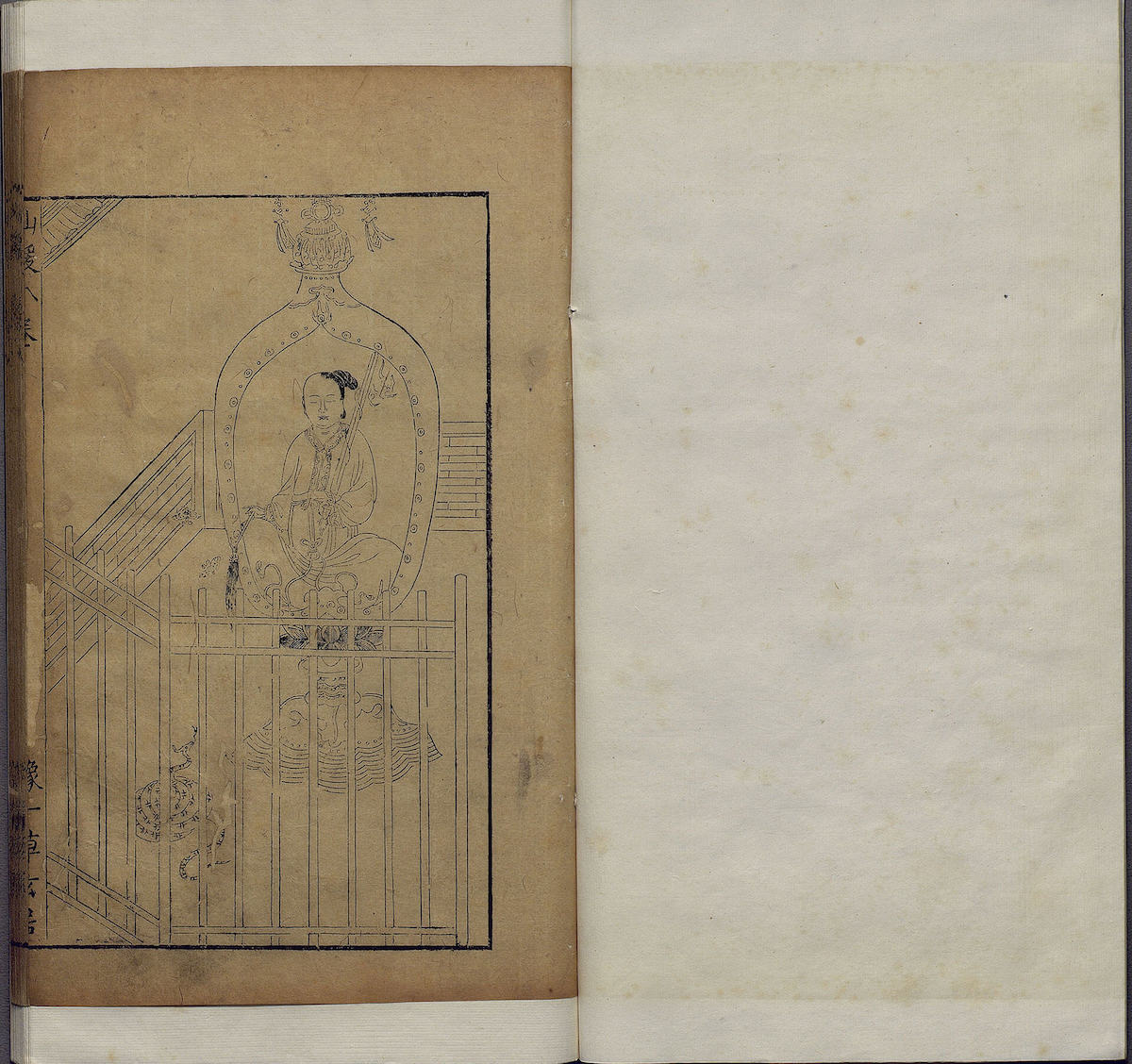
Ming Yang Erzeng's newly engraved Xianyuan Chronicle, the third edition of Yang's Caoxuanju in the 30th year of Wanli in the Ming Dynasty, the second file 12.28—2023.3.21
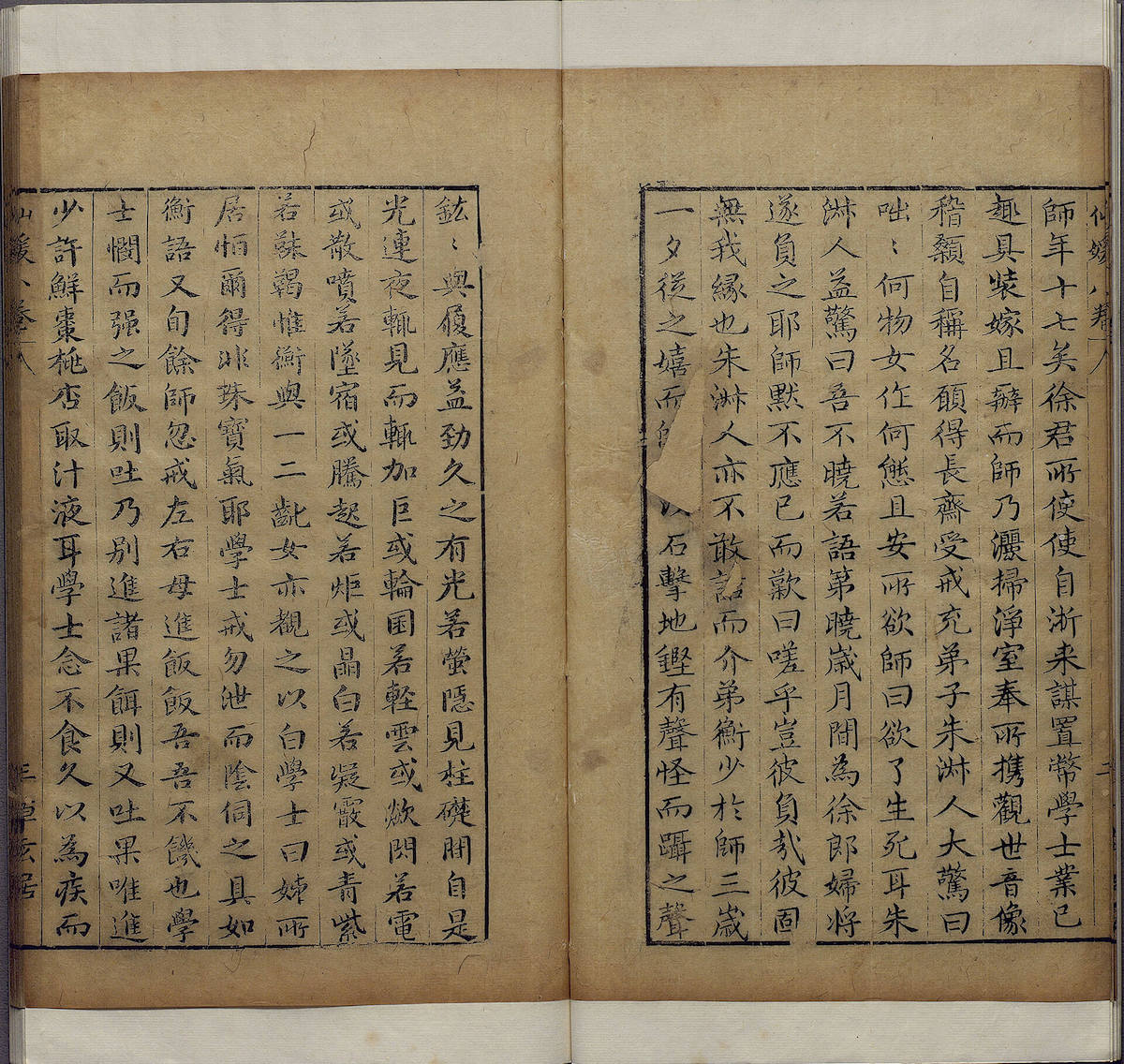
Ming Yang Erzeng's newly engraved Xianyuan Chronicle, the third edition of Yang's Caoxuanju in the 30th year of Wanli in the Ming Dynasty, the second file 12.28—2023.3.21
Wang Xijue (1534-1610), the second queen of Taozhen, who was named "Tanyangzi", sat in front of his fiancé's tomb in the presence of more than 100,000 witnesses. widespread and enthusiastic attention. Wang Shizhen and his "Master Tanyang Biography" are the most important figures and documents leading the "God-creation Movement", and they have also driven the trend of editing and publishing biographies of gods. Yang Erzeng's "Newly Engraved Xianyuan Chronicle" came into being under such a cultural background. It selects and records the stories of women who cultivated and became immortals in the past dynasties. Combined with the drawings and outstanding carvings of Huizhou printmaking artists, it promotes texts and beliefs through exquisite publications. Spread with beauty.
The Prince's Revenge and History
There are many references to the extravagant sensuality of Yan Shifan (1513-1565), the son of Yan Song, in Jin Ping Mei, which is probably Wang Shizhen's revenge work. The drama "Ming Feng Ji", which was completed shortly after Yan Shifan's execution, more profoundly exposed Yan Song's father and son's authoritarian bribery and his party's calamity to the country and the people. It was also classified as a masterpiece by Wang Shizhen and his followers. Through the retelling of "Ming Feng Ji" and the popularity of the novel "Jin Ping Mei", and the "First Fu Biography since Jiajing" written by Wang Shizhen became the foundation of Ming history, the image of Yan Song's father and son's traitorous officials was firmly rooted in the people and was also permanently published. in the history books. With her strong cultural discourse power and historical talents, Wang Shizhen finally avenged her father's revenge through writing and historical writing. The difficulties of the family and the ups and downs of the official sea made Wang Shizhen devoted to the creation and evaluation of art and literature. The prosperity of the late Ming Dynasty was also passed on to future generations through his observation and writing, and through his leadership, it had a new style.

Ming Anonymous Mingfeng Ji, Ming Yushan Mao's Jigu Pavilion published in Qing Dynasty repaired version, the first file 10.5-12.25
"Ming Feng Ji" describes that during the Jiajing period of the Ming Dynasty, there were eight loyal ministers including Xia Yan (1482-1548) and Yang Jisheng (1516-1555), who fought against Yan Song's (1480-1567) father and son's atrocities of stealing power and helping evil; Most of the characters in the show appear under their real names, and some of the plots are also played out according to historical events. After the play came out, it was sung and performed for a long time, and the image and evaluation of Yan Song's wickedness and evil were deeply rooted in the hearts of the people. It is precisely because of this literary appeal that "it makes people feel like a thief with a knife", many scholars since the Ming and Qing dynasties believe that the author of "Ming Feng Ji" is Wang Shizhen or one of his disciples.
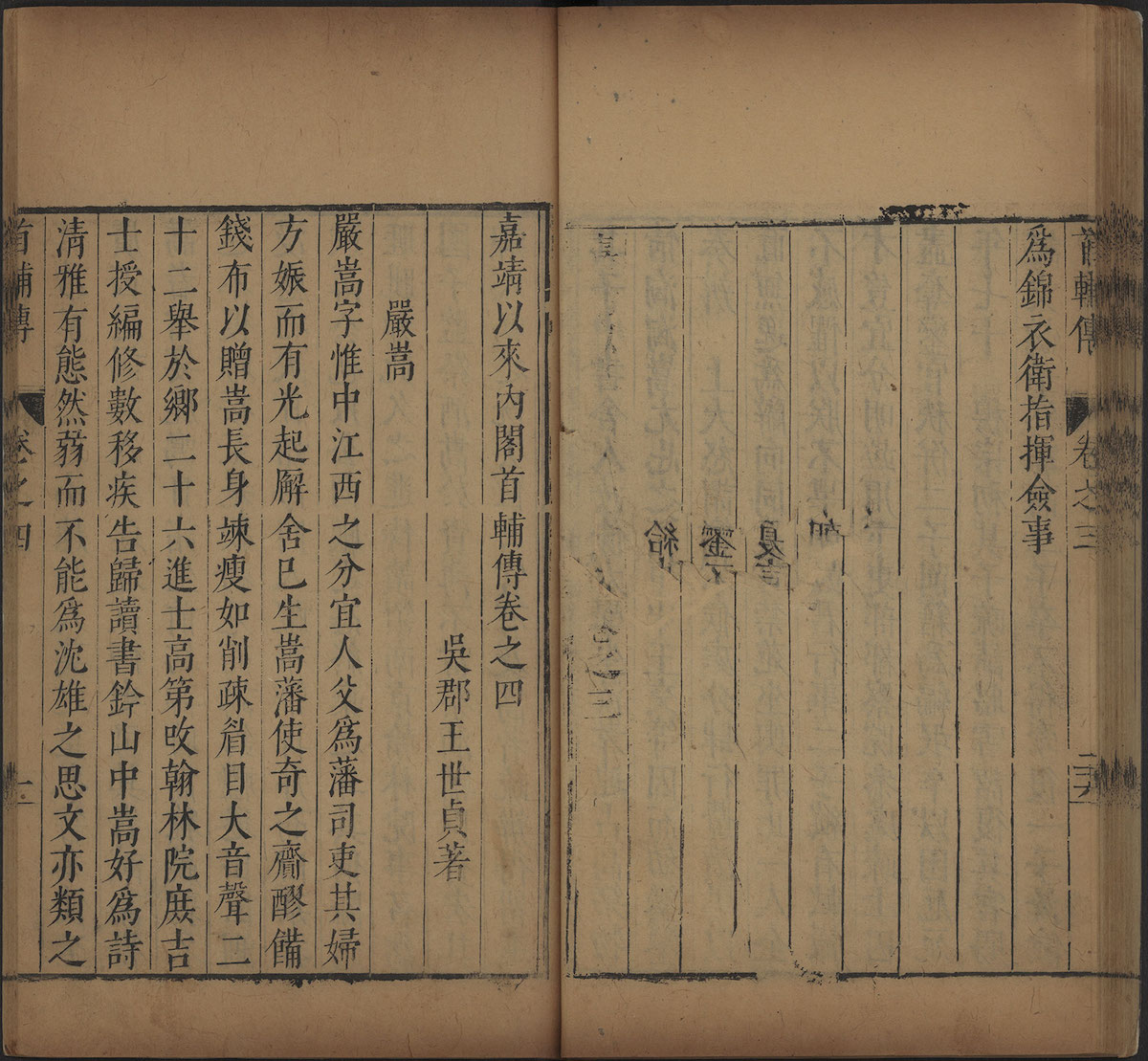
The first biography of the cabinet since King Shizhen of the Ming Dynasty and Jiajing, the first edition of the Ming edition 10.5—12.25
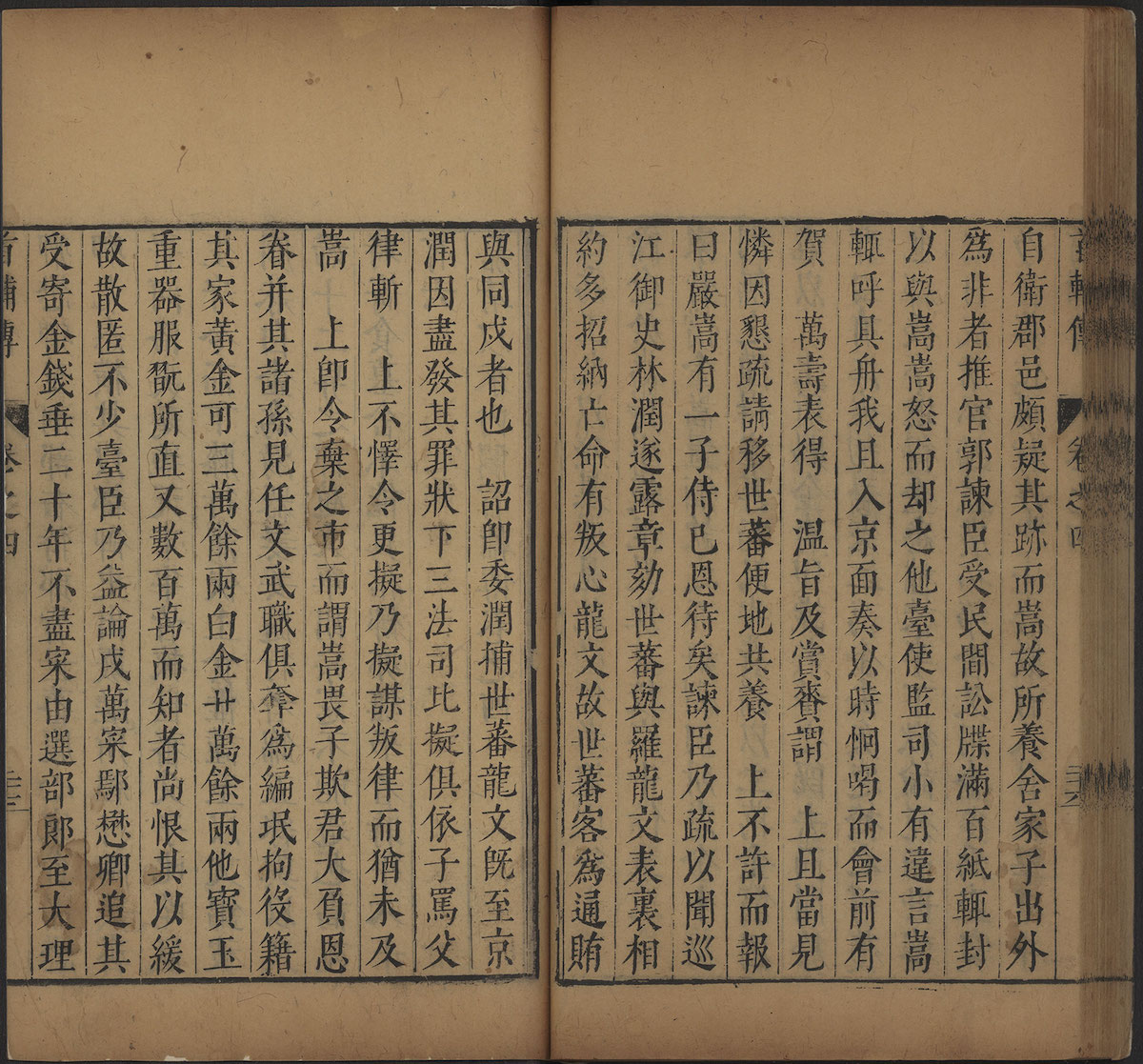
The first biography of the cabinet since King Shizhen of the Ming Dynasty and Jiajing, the first edition of the Ming edition 10.5—12.25
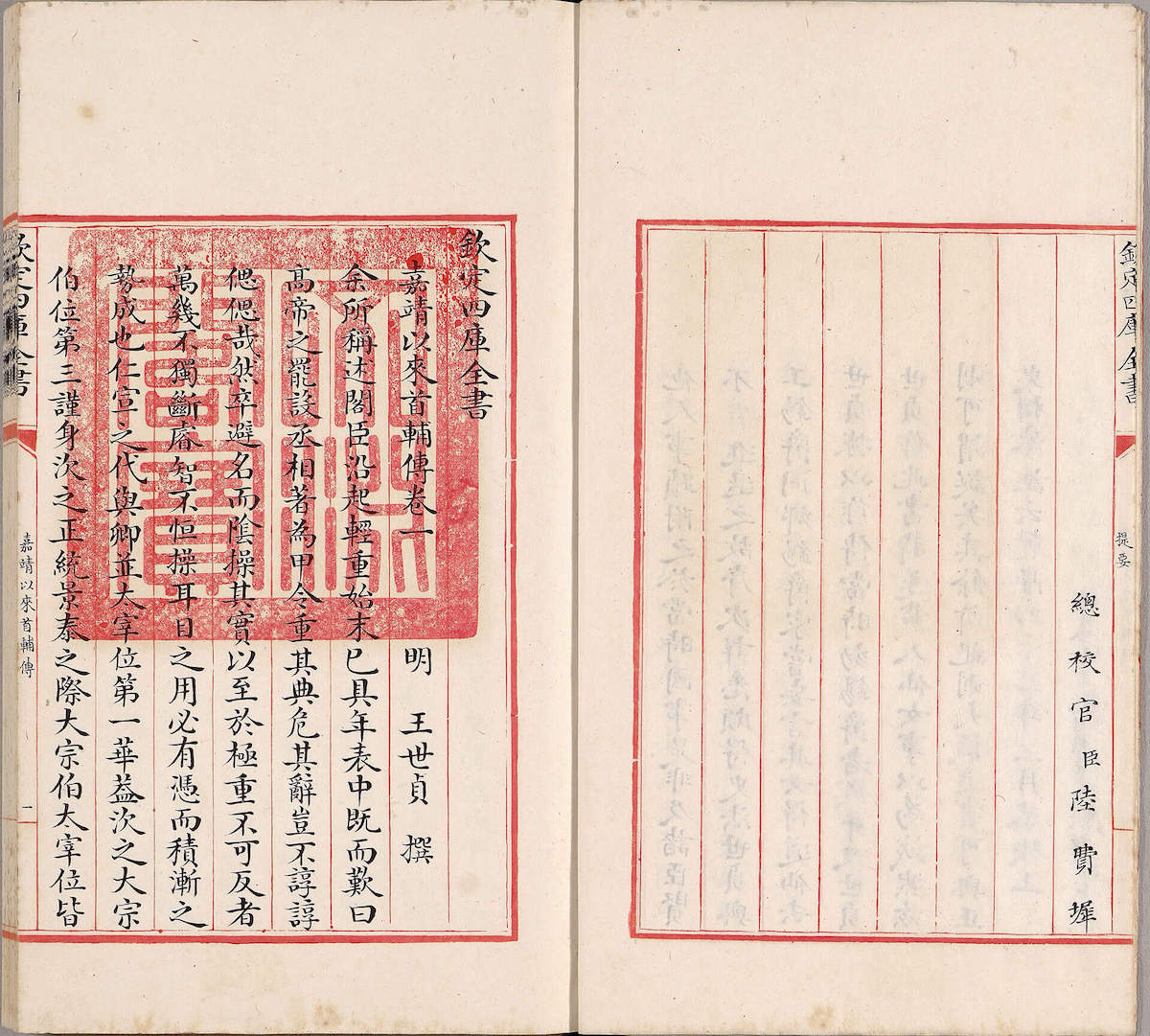
Ming Wang Shizhen, the first auxiliary biography since the Jiajing period, wrote Wenyuange Siku Quanshu during the Qianlong period of the Qing Dynasty, National Treasure 2nd file 12.28—2023.3.21
The "First Auxiliary Biography since Jiajing" recorded in Siku Quanshu, originally titled "The First Auxiliary Biography of the Cabinet since Jiajing" in the Wanli edition of the Ming Dynasty, is an important work of Wang Shizhen.
Historiography is one of the main points of Wang Shizhen's writings, and he uses it to comment on world affairs. In the early Ming Dynasty, the prime minister system was abolished, and a cabinet was set up as an auxiliary government. This book is the deeds of the cabinet and ministers of the three dynasties of Emperor Shizong, Muzong and Shenzong of the Ming Dynasty. The father and son Yan Song (1480-1567), who had all kinds of grievances and grievances with the Wang family, took up a lot of space. Although the discussion was inevitably controversial, it became an important source for later generations to judge the merits and demerits of Yan Song's father and son. It is reported that the exhibition will be displayed in two periods, the first period is from October 5, 2022 to December 25, 2022; the second period is from December 28, 2022 to March 21, 2023.
(This article is compiled from relevant information on the official website of the National Palace Museum in Taipei.)

